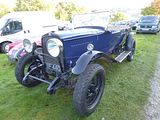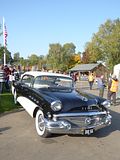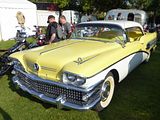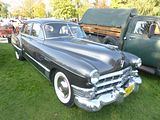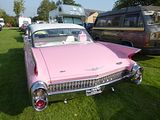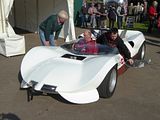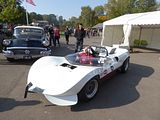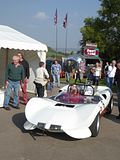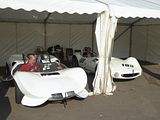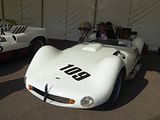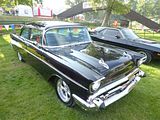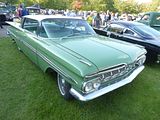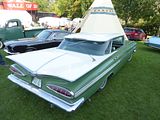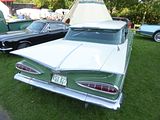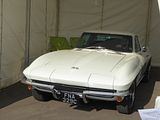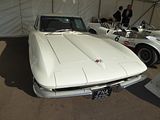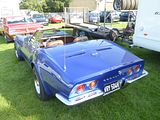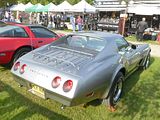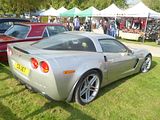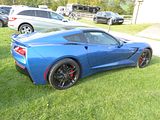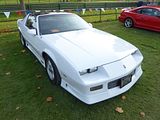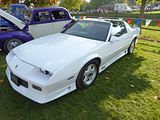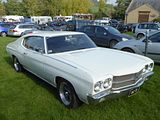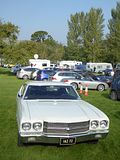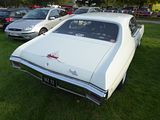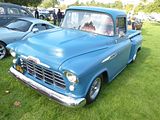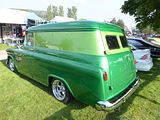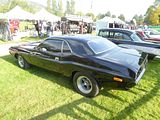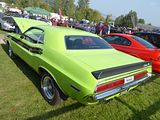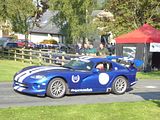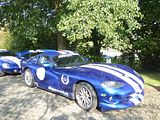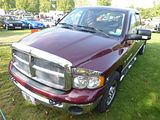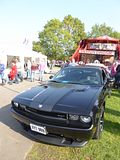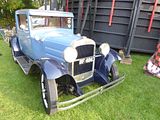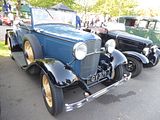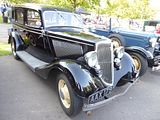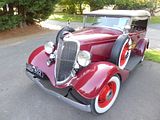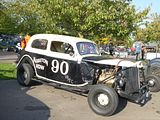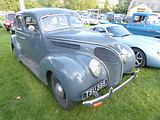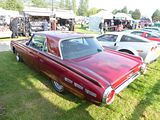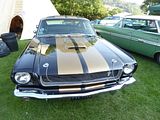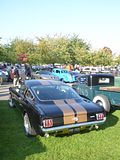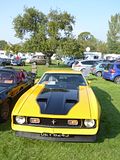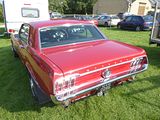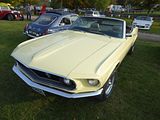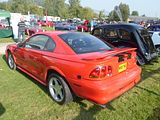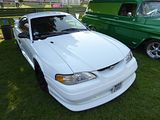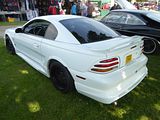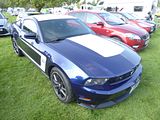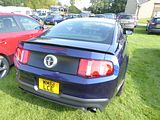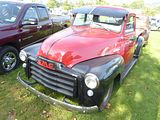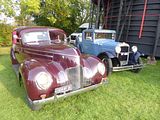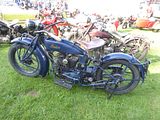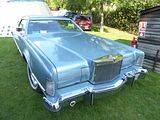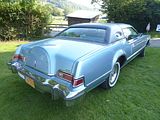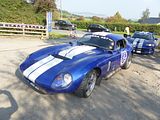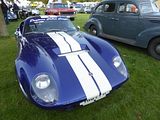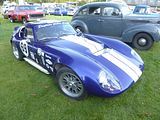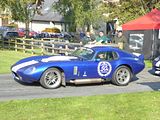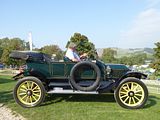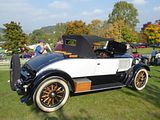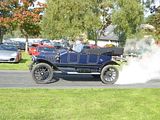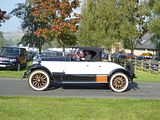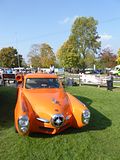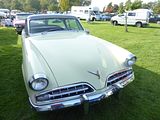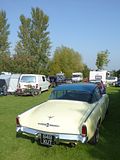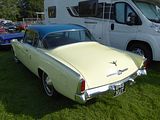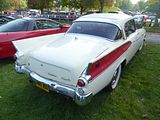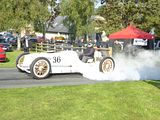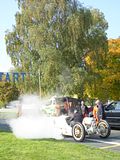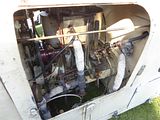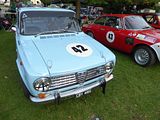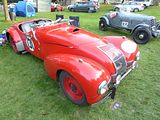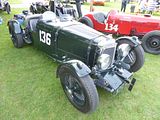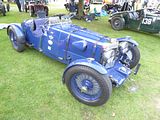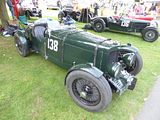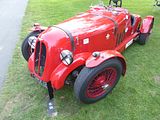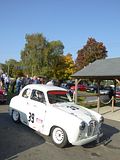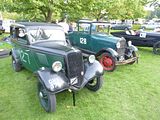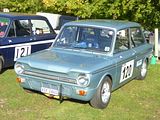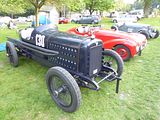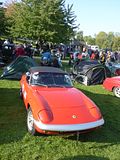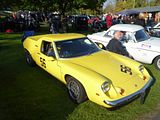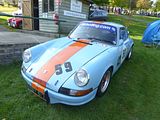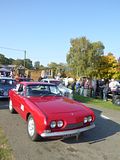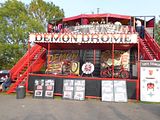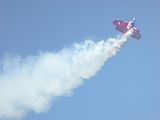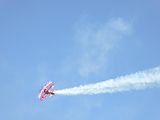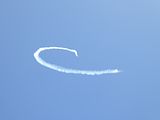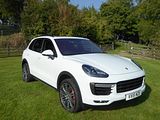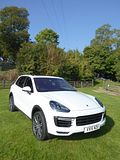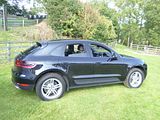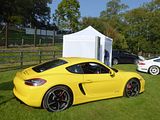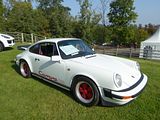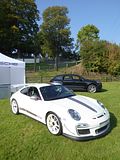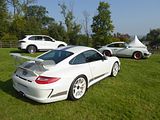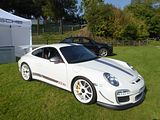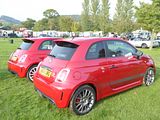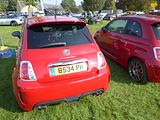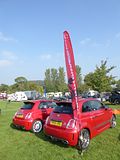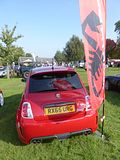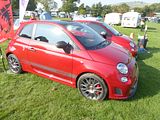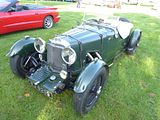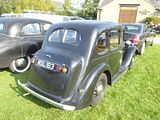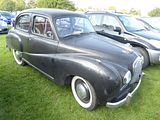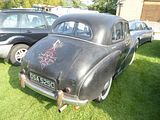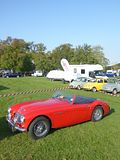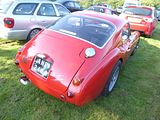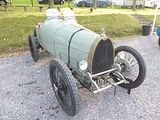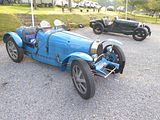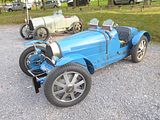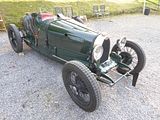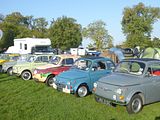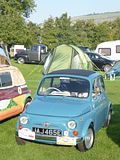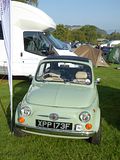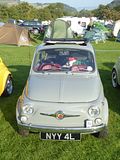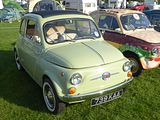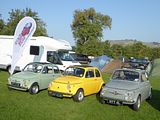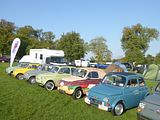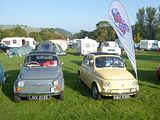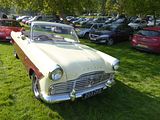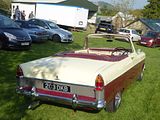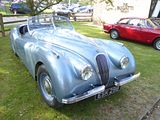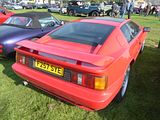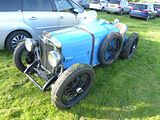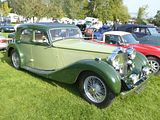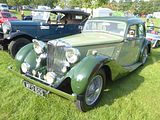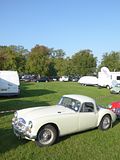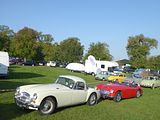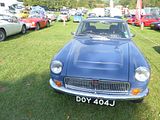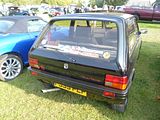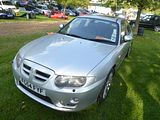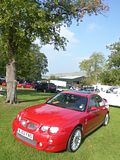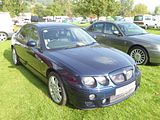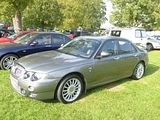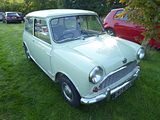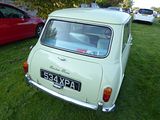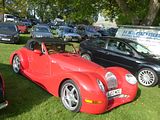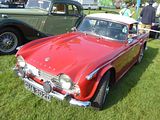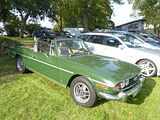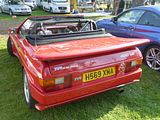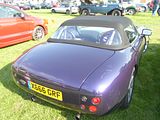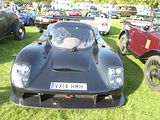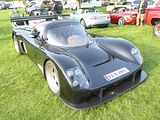For the final event of the season at Prescott, there’s been an American theme for the past few years, and although you might think that something which revels in the biggest, brightest, and brashest cars this side of the pond would be somewhat at odds with the usual ambience to be experienced on these Gloucestershire slopes, the idea seems to have struck a chord with the paying public, and every year, the Stars and Stripes associated content has got bigger and bigger, in support of a full weekend of hill climbing activity. Special displays fill the Paddock area and flow on into the Orchard with content provided by a number of American car clubs, ranging from Pontiacs, Mustangs, Cadillacs, and Chevys to Flatheads, Hotrods, Indian motorcycles and a popular return of the Vintage Hot Rod Association. With stunning Stanley Steamers, mad Model T Fords, 1950s California Chromed Cruisers, 1960s mean muscle Mustangs and a wheel-smokin’ Viper, there’s an American car for almost every taste. And speaking of taste, the food goes decidedly transatlantic as well, with burgers and fries on offer at the catering establishments, and it was announced that the Paddock would reverberate – when the engines don’t drown the sound out – to the rockabilly band The Bravo Boys plus vocalist Michael Ian Brown performing a selection of American ’50s jukebox classics by Elvis, Ritchie Valens, Bill Haley & His Comets, Jerry Lee Lewis, Buddy Holly, the Beach Boys, Johnny Cash and more. Couple that with all the attractions that come as standard with any meeting at Prescott, with classes of all manner of cars taking to the hill trying to post one last season’s best and the stage is set for a fitting end to the year. By early October, the weather can be even more of a gamble than is always the case in the UK, and I certainly remember wallowing in several inches of gooey mud at this event a couple of years back, but for 2015, we were blessed with dry conditions underfoot and a day which started with perfect autumn sunshine, and although it did cloud over somewhat during the morning, it made for a particularly agreeable day out. I was only able to attend on the second day of a two day meeting, and here are the highlights of what I saw.
AMERICANA
Few American cars have been sold new to the British market but there are a surprising number of them which have been brought into the UK over the years, and the owners of them are – perhaps not surprisingly – particularly enthusiastic about their cars, so whenever there is an American theme, you can be sure of a good turn out of cars, some of which will be a lot more familiar to British eyes than others. Indeed, among the cars to be seen here was models and marques that everyone recognises and more than a few, long since extinct, where even a good look at the badge left the attendee not a lot the wiser.
BUICK
This splendid period piece, so redolent of the mid 1950s is a 1956 Buick Century. Buick used the Century name for a series of cars from 1936 to 1942, again from 1954 to 1958, and for a third time from 1973 to 2005 for a series of generations of their mid-size car. The model name Century came about when Buick was designing its first production automobile capable of reaching a speed of 100 mph. The division needed to come up with a name. One of the Buick executives had returned from a recent trip to the UK and on his return he told the other executives that the British referred to going at 100 mph as “doing the century”. The executives liked the Century name and it stuck. The first Century was introduced in 1936, a new name for the Series 60 which sat in the middle of the product range. The name would be reintroduced for 1954, using the same formula as before of mating the smaller, lighter Buick Special body to its largest and most powerful 322 cubic inch V8 engine with the intent of giving Buick a performance vehicle. Included in the model lineup during this period was a station wagon model, a body style that had been unavailable during the Century’s first production period of 1936 to 1942. Introduced in the middle of the 1955 model year the 4-door Buick Century Riviera along with the 4-door Special Riviera and the 4-door Oldsmobile 98 Holiday and 4-door 88 Holiday, were the first 4-door hardtops ever produced. This was the first time “VentiPorts” appeared on the Century, a carryover from the Buick Roadmaster. In 1955, the California Highway Patrol placed a large fleet order for Century 2-door sedans, a body style unavailable to the general public. It combined the Special 2-door sedan body shell with Century powertrain and trim. Broderick Crawford was shown driving a 2-door Century sedan during the first season of his popular syndicated TV series “Highway Patrol”. The Century remained Buick’s performance line, with engine power rising from 200 (SAE gross) in 1954, to 236 in 1955, to 255 in 1956, and topping out at 300 from a bored-out 364 cu in (6.0 litre) engine in 1957-58, the last model years for the full sized Century line before the model was restyled and renamed the Invicta.
Buick used the Special badging on their lowest price model range. Between 1936 and 1958, it was applied to a full-sized model, before the badge had a couple of years rest, only to return on a smaller car. That means that this dramatic looking car, one which I have seen at this event a number of times before, is one of the last of the large Buicks to bear the moniker. The 1958 cars were based on the model first introduced in the middle of the 1955 model year. The four-door Buick Special Riviera (along with the Century Riviera, the Oldsmobile 98 Holiday, and the 88 Holiday) were the first four-door pillarless hardtops ever produced. By then, the Buick Special was one of America’s best selling automotive series. For 1956 the larger 322 cu in (5.3 litre) V8 engine was shared with the rest of the range, although it was replaced by the bigger, 250 hp 364cu in V8 for 1957. This year also brought all-new bodywork, as well as a four-door hardtop station wagon called the Buick Caballero. The 1957 wheelbase remained 122 inches. 1958 brought the most chrome yet and twin headlights, as the car grew longer and wider, albeit on an unchanged chassis.
Buick first used the name Electra in 1959, and it was continuously applied to the top models in the range right through to 1990. Classical scholars may think that the name came from Greek mythology, but in fact, it was the name of the President of General Motors’ sister-in-law, Electra Waggoner Biggs. Seen here is an Electra 225 from 1969. That model year saw a major restyling to the car and indeed the other GM B-body and C-body cars with somewhat crisper bodylines than the 1965–68 models, even though these new cars continued with the same chassis and inner body structure that had been introduced with the 1965 model. This was an era of huge cars, so the wheelbase was increased one inch to 127-inch.
CADILLAC
The 62 Series were a line of Cadillac models made from 1941 through to 1964 when the name Calais was adopted, and they accounted for the vast majority of the marque’s sales during this time. Seen here is an example of the third generation model which was produced between 1948 and 1953. It was available in a variety of body styles, ranging from the 4 door Sedan seen here, to 2 door Coupe and Hardtop as well as Convertible models. It was a big car, with a 126 inch wheelbase. Power came from 5,4 and 5.7 litre V8 engines coupled either to a four speed manual or three speed automatic gearbox. The 62 Series cars were popular, selling a few cars short of 60,000 units in 1950.
The 1959 Cadillac is remembered for its huge sharp tailfins with dual bullet tail lights, two distinctive rooflines and roof pillar configurations, new jewel-like grille patterns and matching deck lid beauty panels. In 1959 the Series 62 had become the Series 6200. De Villes and 2-door Eldorados were moved from the Series 62 to their own series, the Series 6300 and Series 6400 respectively, though they all, including the 4-door Eldorado Brougham (which was moved from the Series 70 to Series 6900), shared the same 130 in wheelbase. New mechanical items were a “scientifically engineered” drainage system and new shock absorbers. All Eldorados were characterised by a three-deck, jewelled, rear grille insert, but other trim and equipment features varied. The Seville and Biarritz models had the Eldorado name spelled out behind the front wheel opening and featured broad, full-length body sill highlights that curved over the rear fender profile and back along the upper beltline region. Engine output was an even 345 hp from the 390 cu in (6.4 litre) engine. Standard equipment included power brakes, power steering, automatic transmission, back-up lamps, two-speed wipers, wheel discs, outside rearview mirror, vanity mirror, oil filter, power windows, six way power seats, heater, fog lamps, remote control deck lid, radio and antenna with rear speaker, power vent windows, air suspension, electric door locks and license frames. The Eldorado Brougham also came with air conditioning, automatic headlight dimmer, and a cruise control standard on the Seville and Biarritz trim lines. For 1960, the year that this Fleetwood Eldorado was made, the styling was toned down a little. General changes included a full-width grille, the elimination of pointed front bumper guards, increased restraint in the application of chrome trim, lower tailfins with oval shaped nacelles and front fender mounted directional indicator lamps. External variations on the Seville two-door hardtop and Biarritz convertible took the form of bright body sill highlights that extended across the lower edge of fender skirts and Eldorado lettering on the sides of the front fenders, just behind the headlamps. Standard equipment included power brakes, power steering, automatic transmission, dual back-up lamps, windshield wipers, two-speed wipers, wheel discs, outside rearview mirror, vanity mirror, oil filter, power windows, six-way power seats, heater, fog lamps, Eldorado engine, remote control trunk lock, radio with antenna and rear speaker, power vent windows, air suspension, electric door locks, license frames, and five whitewall tyres. Technical highlights were finned rear drums and an X-frame construction. Interiors were done in Chadwick cloth or optional Cambray cloth and leather combinations. The last Eldorado Seville was built in 1960. The idea of a large car finished in pink now is simply unthinkable, but the colour goes quite well with the style here. These 59 and 60 Cadillacs attract lots of interest from collectors and the public and this one was no exception.
CHAPPARAL
Making another appearance at this event were a pair of Chaparral cars. Named after a fast-running ground cuckoo that is commonly known as a chaparral or a roadrunner, Chaparral Cars was an American racing team which was founded in 1962 by Formula One racer Hap Sharp and Jim Hall, a Texas oil magnate with both engineering and race car driving skills. Jim Hall raced the front-engined Chaparral (retroactively called the “Chaparral 1”) through 1962, bought from Troutman & Barnes (like the Scarab, the Chaparral 1 cars were built in California by Troutman & Barnes). Hall and Hap Sharp extensively modified their Chaparral, and eventually decided to build their own car. They obtained permission from Troutman & Barnes to use the Chaparral name, which is why all of Hall’s cars are called Chaparral 2s. The two cars on show here were Chaparral 2 models. The first Chaparral 2-Series was designed and built to compete in the United States Road Racing Championship and other sports car races of the time, particularly the West Coast pro Series races that were held each autumn. Hall had significant “under the table” assistance from GM, including engineering and technical support in the development of the car and its automatic transmission (this is evidenced by the similarity between the Chevy Corvette GS-II “research and development” car and the Chaparral 2A through 2C models). First raced in late 1963, the Chaparral 2 developed into a dominant car in the CanAm series in 1966 and 1967. Designed for the 200 mile races of the CanAm series, it was also a winner in longer endurance races. In 1965 it shocked the sportscar world by winning the 12 Hours of Sebring in a pouring rain storm, on one of the roughest tracks in North America. The Chaparral 2 featured the innovative use of fibre glass as a chassis material. The Chaparral 2C had a conventional aluminium chassis. It is very difficult to identify all iterations of the car as new ideas were being tested continually. The 2A is the car as originally raced, featuring a very conventional sharp edge to cut through the air. It also featured a concave tail reminiscent of the theories of Dr. Wunibald Kamm. The first aerodynamic appendages began to appear on the 2A almost immediately to cure an issue with the front end being very light at speed with a consequent impact on steering accuracy and driver confidence. As the car evolved, it grew and changed shape. Most call these the 2B, as raced through the end of 1965. The cars on show here were a 2A and a recreation of the 2B. One of them made a number of sorties up the hill, and you knew when it was being prepared, as the noise was really something else.
CHEVROLET
Oldest Chevrolet here was a 1950 Deluxe four door sedan. In 1949, all the Chevrolets had received their first new styling since the war, and the Deluxe was the brand new upper-end model for Chevrolet. The cheapest Deluxe was the Deluxe Styleline 6-passenger sedan, costing $1,492. Brakes were 11-inch drums. It has full instrumentation and the front suspension had stabilizers. Many things changed starting in 1950, starting with a luxuriously-appointed hardtop coupe, called the Bel Air. The new Bel Air including upgraded cord and leather-grain vinyl trim (available in a choice of several two-tone schemes), full carpeting and other appointments not available in even the Deluxe series, and a wide range of two-tone paint schemes. The 1950-1952 Bel Airs — during these early years, the Bel Air was officially part of the Deluxe range — shared only their front sheetmetal ahead of the A-pillar with the rest of the range. The windshield, doors, glass, and boot were common with the Styleline convertible, but the roof, rear quarters and rear windows were unique. The other change was the availability of Powerglide, a two-speed automatic transmission, exclusively in the Deluxe and Bel Air models. It was powered by a 235-cubic inch six-cylinder engine developing 105 hp had a 3.55:1 rear differential; the engine went on to become the “Blue Flame six.” Models sold with the standard three-speed manual transmission got the usual 216.5-cubic inch engine, developing 92 hp. Throughout the post-war years, many comfort, convenience and styling options were available, including tinted glass which was introduced in 1952, the final year for this style.
After the end of the 1952 model year, the old nameplates — Special and Deluxe — were retired, and changed to 150 and 210, respectively, with trim similar to their respective former series. The Bel Air model became a full series, including two- and four-door sedans, station wagon and convertible; and represented the top-end model with features similar to the 1950-1952 models. The Chevrolet Two-Ten, or 210 was the midrange model of the Chevrolet car from 1953 to 1957. It took its name by shortening the production series number (2100) by one digit in order to capitalise on the 1950s trend toward numerical auto names. The numerical designation ‘”210″‘ was also sporadically used in company literature. The Two-Ten was discontinued after the 1957 model year to be replaced by the Biscayne. The 210 was the best-selling Chevrolet model during 1953 and 54, offering a balance of style and luxury appointments unavailable in the base 150 series, but was less costly than the glitzy Bel Air. Two-Tens offered the widest choice of body styles for 1953, including a convertible, Sport Coupe hardtop, two- and four-door sedans, and four-door station wagons. The 1953 and 1954 models were very similar, with only minor changes between the model years. Two engines were used in each of the ’53-’54 model years, the more powerful 115 hp Blue Flame unit used with the Powerglide automatic transmission. All Two-Tens had a 3 speed Synchromesh manual transmission as standard, with two optional transmissions. All engines are of the overhead valve design. They are commonly referred to as “Stovebolt Sixes” because of the large slotted-head screws used to fasten the valve cover and pushrod covers to the block. 1954 was the last year for 6 volt electrical systems in Chevrolet vehicles.
Chevrolet replaced the entire range of cars for 1955, producing what are sometimes referred to as the “Tri-Five” range, which would live for three years. Revolutionary in their day, they spawned a cult following that exists in clubs, website and even entire businesses that exclusively cater to the enthusiasts of the Tri Five automobiles. All featured a front-engine, rear-wheel-drive layout. They remain some of the most popular years for collectors and hot rodders. 1955-1957 were watershed years for Chevrolet, who spent a million dollars in 1956 alone for retooling, in order to make their less expensive Bel Air models look more like a Cadillac, culminating in 1957 with their most extravagant tailfins and Cadillac inspired bumper guards. In 1955, Americans purchased 7.1 million new automobiles, including 1.7 million Chevrolets, giving the company fully 44% of the low-price market and surpassing Ford in total unit sales by 250,000. The Bel Air was an instant hit with consumers, with Base One-Fifty models starting under $1600 and featuring a six cylinder engine. The introduction of the new optional 170 hpr 265ci V8, coupled with the Powerglide automatic transmission quickly earned the model the nickname “The Hot One”. In the first year of production, the oil filter was considered an option, although not having it led to significantly shorter engine life. With three basic model lines of 150, 210 and Bel Air and a range of body styles from 2 and 4 door Sedans to Coupes, Convertibles and Wagons, there were as many as 19 different Tri-five models available. The 1956 cars saw minor changes to the grille, trim and other accessories. It meant huge gains in sales for Chevrolet, who sold 104,849 Bel Air models, due in part to the new V8 engine introduced a year before. By this time, their 265cid V8 had gained popularity with hot rodders who found the engine easy to modify for horsepower gains. This wasn’t lost on Chevrolet’s engineers, who managed to up the horsepower in 1956 from 170 hp to 225 hp with optional add-ons. The average two door Bel Air in 1956 sold for $2100, which was considered a good value at the time. Prices ranging from $1665 for the 150 sedan with six cylinder engine to $2443 for the V8 equipped convertible, with Nomad models running slightly higher. Bigger changes came for 1957, including the large tailfins, “twin rocket” bonnet design, even more chrome, tri-colour paint and a choice from no less than seven different V8 engines. While in 1957, Ford outsold Chevrolet for the first time in a great while, years later the used 1957 Chevrolets would sell for hundreds more than their Ford counterparts. As the horsepower race continued, Chevrolet introduced a new version of their small block, with 283 cubic inches of displacement and 245 hp. They also introduced a limited number of Rochester fuel injected 283 engines that produced 283 hp, the first production engine to achieve 1 hp per cubic inch. For all intent and purposes, this made the 1957 Bel Air a “hot rod”, right off the production line. It was available with manual transmission only. The base 265cid engine saw an increase from 170 to 185 hp as well. While not as popular as the previous year’s offering, Chevrolet still managed to sell 1.5 million cars in 1957. Today, a 1957 Chevrolet Bel Air like this one is one of the most sought after collector cars ever produced
Chevrolet first used the Impala name in 1958, when it was applied to a new model which sat above the Bel Air as a top of the line model. It differed from the cheaper models in the range from behind the windscreen with a longer wheelbase even though the overall length was the same, as well as upgraded trim. It proved popular, accounting for 15% of total Chevrolet sales for the year. For 1959, Chevrolet completely redesigned their entire product range, and once again there was an Impala included. Sharing bodyshells with lower-end Buicks and Oldsmobiles as well as with Pontiac, part of a GM economy move, the Chevrolet’s wheelbase 1-1/2 inches longer. Using a new X-frame chassis, the roof line was three inches lower, bodies were two inches wider, and curb weight increased. Its tailfins protruded outward, rather than upward. The taillights were a large “teardrop” design at each side and were the largest yet (and indeed, ever) seen. The Impala became a separate model in its own right, adding a four-door hardtop and four-door sedan, to the two-door Sport Coupe and convertible. Sport Coupes featured a shortened roof line and wrap-over back window. The standard engine was an inline 6, while the base V8 was the carryover 283 cu in (4,640 cc), at 185 hp Optional were a 283 cu in with 290 hp and 348 cu in (5,700 cc) V8 up to 315 hp. Standard were front and rear armrests, an electric clock, dual sliding sun visors, and crank-operated front vent windows. A contoured hooded instrument panel held deep-set gauges. A six-way power seat was a new option, as was “Speedminder”, for the driver to set a needle at a specific speed and a buzzer would sound if the pre-set was exceeded. The model continued into 1960, though there were styling changes, with the tail fins reduced somewhat, as well as a reinstatement of three round taillights on each side, a nonfunctional front air intake scoops, and a white band running along the rear bumper. The available V8s were reduced to seven, in 283-cu in or 348-cu in displacements. The Turbo-Fire 283 cu in V8 could have either 170 or 230 hp. The 348 cu in was available in 250 to 320 hp with a 350 hp Super Turbo-Thrust Special with triple two-barrel carburettors, 11.25:1 compression ratio, and dual exhausts. Fuel injection was no longer an option on full-size Chevrolets. New to the options list was speed and cruise control. Production was 490,000 units before a completely new model appeared for 1961. Right hand drive models were made in Oshawa, Ontario in Canada, for New Zealand, Australia, and South Africa which were then assembled locally from CKD or SKD kits. The right-hand drive dashboard was a mirror image of the 1959 Chevrolet panel and shared with equivalent right-hand drive Pontiac models. Australian models were assembled by hand on the GMH Holden assembly lines. Seen here is a 1959 four-door hardtop with those amazing tail fins.
There were lots of Corvette models here. Looking through the pictures, I got the point of hoping that there was at least one of each of the 7 distinct generations that have been offered since the 1953 launch of this icon, but sadly there were no example of the first generation car present The second generation, sometimes referred to as the C2, was launched in 1963. This model introduced us to the name Sting Ray. It continued with fibreglass body panels, and overall, was smaller than the first generation. The car was designed by Larry Shinoda with major inspiration from a previous concept design called the “Q Corvette,” which was created by Peter Brock and Chuck Pohlmann under the styling direction of Bill Mitchell. Earlier, Mitchell had sponsored a car known as the “Mitchell Sting Ray” in 1959 because Chevrolet no longer participated in factory racing. This vehicle had the largest impact on the styling of this generation, although it had no top and did not give away what the final version of the C2 would look like. The third inspiration was a Mako Shark Mitchell had caught while deep-sea fishing. Production started for the 1963 model year and ended in 1967. The 1963 model was the first year for a Corvette coupé and it featured a distinctive tapering rear deck (a feature that later reappeared on the 1971 “Boattail” Buick Riviera) with, for 1963 only, a split rear window. The Sting Ray featured hidden headlamps, non-functional bonnet vents, and an independent rear suspension. Corvette chief engineer Zora Arkus-Duntov never liked the split rear window because it blocked rear vision, but Mitchell thought it to be a key part of the entire design. Maximum power for 1963 was 360 bhp, raised to 375 bhp in 1964. Options included electronic ignition, the breakerless magnetic pulse-triggered Delcotronic first offered on some 1963 Pontiac models. On 1964 models the decorative bonnet vents were eliminated and Duntov, the Corvette’s chief engineer, got his way with the split rear window changed to a full width window.
Four-wheel disc brakes were introduced in 1965, as was a “big block” engine option: the 396 cu in (6.49 litre) V8. Side exhaust pipes were also optionally available in 1965, and continued to be offered through 1967. The introduction of the 425 bhp 396 cu in big block in 1965 spelled the beginning of the end for the Rochester fuel injection system. The 396 cu in option cost $292.70 while the fuel injected 327 cu in (5.36 litre) engine cost $538.00. Few people could justify spending $245.00 more for 50 bhp less, even though FI could deliver over 20 mpg on the highway and would keep delivering fuel despite high G-loading in corners taken at racing speeds. Another rare ’63 and ’64 option was the Z06 competition package, which offered stiffer suspension, bigger, multi-segment lined brakes with finned drums and more, only a couple hundred coupes and ONE convertible were factory-equipped this way in 1963. With only 771 fuel-injected cars built in 1965, Chevrolet discontinued the option at the end of the ’65 production, having introduced a less-expensive big block 396 engine rated at 425 hp in the middle of the production year and selling over 2,000 in just a few months. For 1966, Chevrolet introduced an even larger 427 cu in 7 litre Big Block version. Other options available on the C2 included the Wonderbar auto-tuning AM radio, AM-FM radio (mid-1963), air conditioning (late-1963), a telescopic steering wheel (1965), and headrests (1966). The Sting Ray’s independent rear suspension was successfully adapted for the new-for-1965 Chevrolet Corvair, which solved the quirky handling problems of that unique rear-engine compact. 1967 was the final year for the C2 generation. The 1967 model featured restyled bumper vents, less ornamentation, and back-up lamps which were on the inboard in 1966 were now rectangular and centrally located. The first use of all four taillights in red started in 1961 and was continued thru the C-2 line-up except for the 1966. The 1967 and subsequent models continuing on all Corvettes since. 1967 had the first L88 engine option which was rated at 430 bhp, but unofficial estimates place the actual output at 560 bhp or more. Only twenty such engines were installed at the factory. From 1967 (to 1969), the Holley triple two-barrel carburettor, or Tri-Power, was available on the 427 L89 (a $368 option, on top of the cost for the high-performance 427). Despite these changes, sales slipped over 15%, to 22,940 – 8,504 coupes and 14,436 convertibles.
The third generation Corvette, patterned after the Mako Shark II concept car, was introduced for the 1968 model year and was in production until 1982. C3 coupes featured the first use of T-top removable roof panels. The C3 introduced monikers that were later revived, such as LT-1, ZR-1, Z07 and Collector Edition. In 1978, the Corvette’s 25th anniversary was celebrated with a two-tone Silver Anniversary Edition and an Indy Pace Car replica edition of the C3. This was also the first time that a Corvette was used as a Pace Car for the Indianapolis 500. Engines and chassis components were mostly carried over from the C2, but the body and interior were new. The 350 cu in (5.7 litre) engine replaced the old 327 cu in (5.36 litre) as the base engine in 1969, but power remained at 300 bhp. 1969 was the only year for a C3 to optionally offer either a factory installed side exhaust or normal rear exit with chrome tips. The all-aluminium ZL1 engine was also new for 1969; the special big-block engine was listed at 430-hp , but was reported to produce 560 hp and propelled a ZL1 through the 1/4 mile in 10.89 seconds. There was an extended production run for the 1969 model year due a lengthy labour strike, which meant sales were down on the 1970 models, to 17,316. 1970 small-block power peaked with the optional high compression, high-revving LT-1 that produced 370 bhp. The 427 big-block was enlarged to 454 cu in (7.44 litre) with a 390 bhp rating. The ZR-1 special package was an option available on the 1970 through 1972 model years, and included the LT-1 engine combined with special racing equipment. Only 53 ZR-1’s were built. In 1971, to accommodate regular low-lead fuel with lower anti-knock properties, the engine compression ratios were lowered which resulted in reduced power ratings. The power rating for the 350 cu in (5.7 litre) L48 base engine decreased from 300 to 270 hp and the optional special high performance LT1 engine decreased from 370 to 330 hp. The big-block LS6 454 was reduced from 450 to 425 bhp, though it was not used in Corvettes for 1970; it was used in the Chevelle SS. For the 1972 model year, GM moved to the SAE Net measurement which resulted in further reduced, but more realistic, power ratings than the previous SAE Gross standard. Although the 1972 model’s 350 cu in horsepower was actually the same as that for the 1971 model year, the lower net horsepower numbers were used instead of gross horsepower. The L48 base engine was now rated at 200 bhp and the optional LT1 engine was now rated at 270 bhp. 1974 models had the last true dual exhaust system that was dropped on the 1975 models with the introduction of catalytic converters requiring the use of no-lead fuel. Engine power decreased with the base ZQ3 engine producing 165 bhp), the optional L82’s output 250 bhp, while the 454 big-block engine was discontinued. Gradual power increases after 1975 peaked with the 1980 model’s optional L82 producing 230 bhp. Styling changed subtly throughout the generation until 1978 for the car’s 25th anniversary. The Sting Ray nameplate was not used on the 1968 model, but Chevrolet still referred to the Corvette as a Sting Ray; however, the 1969 (through 1976) models used the “Stingray” name as one word, without the space. In 1970, the body design was updated including fender flares, and interiors were refined, which included redesigned seats, and indication lights near the gear shift that were an early use of fibre optics . Due to government regulation, the 1973 Corvette’s chrome front bumper was changed to a 5-mile-per-hour (8 km/h)system with a urethane bumper cover. 1973 Corvettes are unique in that sense, as they are the only year where the front bumper was polyurethane and the rear retained the chrome two-piece bumper set. 1973 was also the last year chrome bumpers were used. The optional wire-spoked wheel covers (left) were offered for the last time in 1973. Only 45 Z07 were built in 1973. From 1974 onwards both the front and rear bumpers were polyurethane. In 1974, a 5-mph rear bumper system with a two-piece, tapering urethane bumper cover replaced the Kamm-tail and chrome bumper blades, and matched the new front design from the previous year. 1975 was the last year for the convertible, (which did not return for 11 years). For the 1976 models the fibreglass floor was replaced with steel panels to provide protection from the catalytic converter’s high operating temperature. 1977 was last year the tunnelled roof treatment with vertical back window was used, in addition leather seats were available at no additional cost for the first time. The 1978 25th Anniversary model introduced the fastback glass rear window and featured a new interior and dashboard. Corvette’s 25th anniversary was celebrated with the Indy 500 Pace Car limited edition and a Silver Anniversary model featuring silver over gray lower body paint. All 1979 models featured the previous year’s pace car seats and offered the front and rear spoilers as optional equipment. 53,807 were produced for the model year, making 1979 the peak production year for all versions of the Corvette. Sales have trended downward since then. In 1980, the Corvette received an integrated aerodynamic redesign that resulted in a significant reduction in drag. After several years of weight increases, 1980 Corvettes were lighter as engineers trimmed both body and chassis weight. In mid-1981, production shifted from St. Louis, Missouri to Bowling Green, Kentucky, and several two-tone paint options were offered. The 1981 models were the last available with a manual transmission until well into the 1984 production run. In 1982, a fuel-injected engine returned, and a final C3 tribute Collectors Edition featured an exclusive, opening rear window hatch. Seen here were an early C3 Convertible and a mid 70s Coupe.
The fourth generation Corvette was the first complete redesign of the Corvette since 1963. Production was to begin for the 1983 model year but quality issues and part delays resulted in only 43 prototypes for the 1983 model year being produced that were never sold. All of the 1983 prototypes were destroyed or serialised to 1984 except one with a white exterior, medium blue interior, L83 350 ci, 205 bhp V8, and 4-speed automatic transmission. After extensive testing and modifications were completed, it was initially retired as a display sitting in an external wall over the Bowling Green Assembly Plant’s employee entrance. Later this only surviving 1983 prototype was removed, restored and is now on public display at the National Corvette Museum in Bowling Green, Kentucky. It is still owned by GM. On February 12, 2014, it was nearly lost to a sinkhole which opened up under the museum. Regular fourth generation production began on January 3, 1983; the 1984 model year and delivery to customers began in March 1983. The 1984 model carried over the 350 cu in (5.7 litre) L83 slightly more powerful (5 bhp) “Crossfire” V8 engine from the final 1982 third generation model. New chassis features were aluminum brake calipers and an all-aluminium suspension for weight savings and rigidity. The new one piece targa top had no centre reinforcement. A new electronic dashboard with digital liquid crystal displays for the speedometer and tachometer was standard. Beginning in 1985, the 230 bhp L98 engine with tuned port fuel injection became the standard engine.September 1984 through 1988 Corvettes offered a Doug Nash designed “4+3” transmission – a 4-speed manual coupled to an automatic overdrive on the top three gears. It was designed to help the Corvette meet U.S. fuel economy standards. Since 1981, when it was last offered, a manual transmission returned to the Corvette starting with production in late-1984. The transmission proved to be problematic and was replaced by a modern ZF 6-speed manual transmission in 1989. In 1986, the second Corvette Indy Pace Car was released. It was the first convertible Corvette since 1975. A Centre High Mounted Signal Light – a third centre brake light – was added in 1986 to comply with safety regulations. While the colour of the pace car used in the race was yellow, all 1986 convertibles also had an Indy 500 emblem mounted on the console, making any colour a “pace car edition”. In 1987, the B2K twin-turbo option became available from the factory. The Callaway Corvette was a Regular Production Option. The B2K option coexisted from 1990 to 1991 with the ZR-1 option, which then replaced it. Early B2Ks produced 345 bhp and 450 lb·ft later versions boasted 450 bhp and 613 lb·ft .1988 saw the 35th Anniversary Edition of the Corvette. Each of these featured a special badge with an identification number mounted next to the gear selector, and were finished with a white exterior, wheels, and interior. In 1991, all Corvettes received updates to the body, interior, and wheels. The convex rear fascia that set the 1990 ZR-1 apart from the base model was now included on L98 Corvettes, making the styling of the expensive ZR-1 even closer to that of the base cars. The most obvious difference remaining between the base and ZR-1 models besides the wider rear wheels was the location of the CHMSL, which was integrated into the new rear fascia used on the base model, but remained at the top of the rear-hatch on the ZR-1’s. For the 1992 model year, the 300 bhp LT1 engine was introduced, an increase of 50 bhp over 1991’s L98 engine. This engine featured reverse-flow cooling (the heads were cooled before the block), which allowed for a higher compression ratio of 10.5:1. A new distributor was also debuted. Called “Optispark”, the distributor was driven directly off the front of the camshaft and mounted in front of the timing cover, just above the crankshaft and harmonic balancer. Also new for 1992 was Acceleration Slip Regulation (ASR), a form of traction control which utilised the Corvette’s brakes, spark retard, and throttle close-down to prevent excessive rear wheel spin and possible loss of control. The traction control device could be switched off if desired. A special 40th Anniversary Edition was released in 1993, which featured a commemorative Ruby Red colour, 40th anniversary badges, and embroidered seat backs. The 1993 Corvette also marked the introduction of the Passive Keyless Entry System, making it the first GM car to feature it. Production of the ZR-1 ended in 1995, after 6,939 cars had been built. 1996 was the final year of C4 production, and featured special models and options, including the Grand Sport and Collector Edition, OBD II (On-Board Diagnostics), run flat tires, and the LT4 engine. The 330 bhp LT4 V8 was available only with a manual transmission, while all 300 bhp LT1 Corvettes used automatic transmissions. Chevrolet released the Grand Sport (GS) version in 1996 to mark the end of production of the C4 Corvette. The Grand Sport moniker was a nod to the original Grand Sport model produced in 1963. A total of 1,000 GS Corvettes were produced, 810 as coupes and 190 as convertibles. The 1996 GS came with the high-performance LT4 V8 engine, producing 330 bhp and 340 lb·ft . The Grand Sport came only in Admiral Blue with a white stripe down the middle, and black wheels and two red stripes on the front left wheel arch Seen here was an early C4 coupe and one of the 40th anniversary convertible cars.
There were no examples of the C5 generation here, but there were the more recent C6 and C7 cars. The C6 Corvette retained the front engine and rear transmission design of the C5, but was otherwise all-new, including new bodywork with exposed headlamps (for the first time since 1962), a larger passenger compartment, a new 6.0 litre engine and a reworked suspension geometry. It had a longer wheelbase than the C5, but its overall vehicle length and width were less than the C5, allegedly to widen appeal to the European market.The 6.0 litre LS2 V8 produced 400 bhp at 6000 rpm and 400 lb·ft at 4400 rpm, giving the vehicle a 0–60 time of under 4.2 seconds.Its top speed was 190 mph. The C6 generation did not match the previous generation’s relatively good fuel economy, despite its relatively low 0.28 drag coefficient and low curb weight, achieving 16/26 mpg (city/highway) equipped with automatic or manual transmissions; like all manual transmission Corvettes since 1989, it is fitted with Computer Aided Gear Selection (CAGS) to improve fuel economy by requiring drivers to shift from 1st gear directly to 4th in low-speed/low-throttle conditions. This feature helps the C6 avoid the Gas Guzzler Tax by achieving better fuel economy. The new Z06 arrived as a 2006 model in the third quarter of 2005. It has a 7.0 litre version of the small block engine codenamed LS7. At 427.6 cubic inches, the Z06 was the largest small block ever offered from General Motors. Because of the Corvette’s former use of 427 cubic-inch big blocks in the late-1960s and early 1970s, the LS7’s size was rounded down to 427 cubic inches. Official output was 505 bhp and has a 0-60 mph time of 3.7 seconds. Top speed is 198 mph. For 2008, the Corvette received a mild freshening: a new LS3 engine with displacement increased to 6.2 litres resulting in 430 bhp and 424 lb·ft. The 6-speed manual transmission also has improved shift linkage and a 0–60 time of 4.0 seconds, while the automatic is set up for quicker shifts giving the C6 automatic a 0–60 time of 4.0 seconds, faster than any other production automatic Corvette. The interior was slightly updated and a new 4LT leather-wrap interior package was added. The wheels were also updated to a new five-spoke design. ZR1 was formally announced in a December 2007 press statement by General Motors, where it was revealed that their target of 100 bhp per litre had been reached by a new “LS9″ engine with an Eaton-supercharged 6.2-litre engine producing 638 bhp and 604 lb·ft. The LS9 engine was the most powerful to be put into a GM production sports car. Its top speed was 205 mph. The historical name Grand Sport returned to the Corvette lineup in 2010 as an entirely new model series that replaced the Z51 option. The new model was basically an LS3 equipped Z06 with a steel frame instead of aluminium. It retained many of the features of the Z06 including a wide body with 18×9.5 and 19×12 inch wheels, dry sump oiling (manual transmission coupes only), 6-piston 14” front brakes and 4-piston rear, improved suspension, and front carbon fibre fenders. Manual power train equipped G/S coupe models receive a tweaked LS3 with a forged crank, are built in Z06 fashion by hand, and utilise a dry-sump oil system. The first three gears were also made shorter for better throttle response and faster acceleration. A new launch control system was introduced for all models that allows for sub 4 second 0-60. Beginning with the 2011 model year, buyers of the Corvette Z06 and ZR1 were offered the opportunity to assist in the build of their engine. Titled the “Corvette Engine Build Experience,” buyers paid extra to be flown to the Wixom, Michigan Performance Build Center.Participants helped the assembly line workers build the V8 engine, then took delivery of the car at the National Corvette Museum in Bowling Green, KY, near the Corvette final assembly point. The last C6 Corvette was manufactured in February 2013.
The next-generation (C7) Corvette had been in development since 2007. Originally set to be introduced for the 2011 model year, its introduction was delayed for 3 years. It was finally released for the 2014 model year.Mid-engine and rear-engine layouts had been considered, but the front-engine, rear-wheel drive platform was chosen to keep production costs lower. To GM’s product planners and marketers, the fact that the Corvette had become known as an “old man’s toy” became a prime factor in developing the next generation. Studies showed that about 46 percent of Corvette buyers in 2012, through October, were 55 or older, compared with 22 percent of Audi R8 and 30 percent of Porsche 911 customers. The head of Chevy marketing, Chris Perry, acknowledges that too many people saw it as the car of “the successful plumber.” John Fitzpatrick, Corvette’s marketing manager said “It’s the old saying, ‘Nobody wants to be seen driving an old man’s car, but everybody wants to be seen driving a young man’s car. ” To counter that perception GM planned to make the new generation C7 more aspirational to younger people. Towards that end, a camouflaged version of the car was made available in the popular video game Gran Turismo 5 in November 2012. As part of the marketing effort associated with the introduction of the new generation, the 2013 Indianapolis 500 utilised a Corvette for the 12th time as its pace car. Pace car editions are planned. Sales success of the new Corvette is important to GM. The Motley Fool reports that the Corvette could be earning GM $10,000 or more in gross profit for every Corvette it sells.The 2014 Chevrolet Corvette uses an LT1 6.2 litre V8 making 455 bhp. The LT1 engine is in the Gen 5 family of small block engines, which will be used in GM vehicles as the new small V8 option. It features three technologies new to the GM V8, though widely available on other engines in the marketplace: direct injection, variable valve timing, and an active fuel management system. Fuel injectors are located under the intake manifold. The Corvette remains rear-wheel drive with the transaxle located in the rear. Transmission choices include a 7-speed manual or a 8-speed automatic with paddle shifters. The new interior includes wide-bottom seats as standard, with sportier versions with high side bolsters optional. The Corvette’s flag logo has been revised for the new car and a small casting of a stingray has been added to the car’s ornamentation. Features of the new generation’s structure include a carbon fibre bonnet and removable roof panel. The fenders, doors and rear quarter panels remain composite. At the rear of the car, the trademark round taillights have changed to a more squarish form. The underbody panels are made of “carbon-nano” composite and it makes use of a new aluminium frame which locates the four wheels an inch farther apart, front to rear and side to side. Luggage space decreased by 33% from the previous generation’s. The overall weight of the car was not announced by General Motors for many months after its first showing in January 2013. Despite the increased use of aluminium and other light weight materials, numerous publications reported that the weight would remain essentially unchanged from that of the previous generation’s. In August, 2013, the weight of the new Corvette was reported to be 3,444 lb meaning it would weigh more than the previous generation’s C6 ZR1 model (3,324 lb (1,508 kg)). The ZR1 C6 weight included a supercharger and intercooler on its 6.2 litre engine. Chevrolet announced the C7 Z06 at the 2014 Detroit Auto Show. The 2015 Z06 Corvette has 650 bhp from the supercharged LT4 aluminium 6.2L V-8 engine.
There were a couple of examples of Chevrolet’s smaller performance Coupe, the Camaro as well. Concerned with the runaway success of the Ford Mustang, launched in April 1964, Chevrolet executives realised that their compact sporty car, the Corvair, would not be able to generate the sales volume of the Mustang due to its rear-engine design, as well as declining sales, partly due to the negative publicity from Ralph Nader’s book, Unsafe at Any Speed, GM realised that a new car was needed. It took until September 1966 to get their rival to market. At launch. the Camaro was touted as having the same conventional rear-drive, front-engine configuration as the Mustang and Chevy II Nova. In addition, the Camaro was designed to fit a variety of power plants in the engine bay. The car sat on a new rear-wheel drive GM F-body platform was available as a two-door coupé or convertible with 2+2 seating, and a choice of 230 cu in (3.8 litre), 250 cu in (4.1 litre) inline-6 or 302 cu in (4.9 litre), 307 cu in (5.0 litre), 327 cu in (5.4 litre), 350 cu in (5.7 litre), 396 cu in (6.5 litre), 427 cu in (7.0 litre) V8 powerplants. The first-generation offered a standard, Super Sport, and Rally Sport editions. In 1967, the Z/28 model was added featuring stripes on the bonnet and boot, styled rally road wheels, and a 302 cu in (4.9 litre) V8 engine. The first-generation Camaro lasted until the 1969 model year and eventually inspired the design of the new retro fifth-generation Camaro.
A new Camaro debuted in early 1970 and this would run through to 1982 before replacement. During the 1970s, tougher emissions controls had gradually seen the power of the Camaro reduce, taking much of the edge off the performance of the car, especially in the entry level models. That was not really addressed at launch with the new 1982 models, even though they were nearly 500 pounds lighter than their predecessors. These were the first Camaros to offer modern fuel injection, Turbo-Hydramatic 700R4 four-speed automatic transmissions, five speed manual transmissions, 15 or 16 inch wheels, a standard OHV 4-cylinder engine, and hatchback bodies. The IROC-Z (the IROC stands for International Race of Champions) was introduced in 1985 and continued through 1990. For 1986, the 2.5 litre Iron Duke pushrod 4 cylinder engine was dropped, and all base models now came with the 2.8 litre V6. In 1985, the 305 small block V8 was available with TPI (tuned port injection). In 1987 the L98 5.7 litre V8 engine became a regular option on the IROC-Z, paired with an automatic transmission only. The “20th Anniversary Commemorative Edition” was offered in 1987, as well as a “25th Anniversary Heritage Package” in 1992 that included a 5.0 litre High Output engine. Beginning in 1988, the 1LE performance package was introduced, optional on street models and for showroom stock racing in the U.S. and Canada. The B4C or “police” package was made available beginning in 1991. This basically created a Z28 in more subtle RS styling. The model would last 10 years before being replaced by the fourth generation model.
The Chevrolet Chevelle was a mid-sized muscle car produced in three generations for the 1964 through 1977 model years. Part of the General Motors (GM) A-Body platform, the Chevelle was one of Chevrolet’s most successful nameplates. Body styles included coupes, sedans, convertibles and station wagons. Super Sport versions were produced through the 1973 model year, and Lagunas from 1973 through 1976. After a three-year absence, the El Camino was reintroduced as part of the new Chevelle lineup. The Chevelle also provided the platform for the Monte Carlo introduced in 1970. The Malibu, the top of the line model through 1972, replaced the Chevelle nameplate for the redesigned, downsized 1978 models. Seen here is one of the last of the second generation cars, dating from 1972. Second generation Chevelle models first appeared in 1968, with an all-new distinctly sculpted body with tapered front fenders and a rounded beltline. The car adopted a long-hood/short-deck profile with a high rear-quarter “kick-up”. While all 1967 Chevelle models had a 115-inch wheelbase, the 1968 coupes and convertibles had a shorter 112-inch one The sedans and wagons turned to a 116-inch span. Track width grew an inch front and rear. Hardtop coupes featured a semi-fastback, flowing roofline. Top-trim models including the SS 396 and new luxury Concours featured GM’s new Hide-A-Way wiper system. Lesser Chevelles would get that change later. The Super Sport SS396 sport coupe, convertible, and El Camino pickup became a series on its own. Chevrolet produced 60,499 SS 396 sport coupes, 2,286 convertibles, and 5,190 El Caminos; 1968 was the only year the El Camino body style would get its own SS396 series designation Chevrolet made some fairly significant updates to the car every year, as was common practice on the American market at the time. New front and rear styling came in for 1971, so there were not too many changes for 1972, which would turn out to be the last year before a complete redesign. Even so, the 1972 Chevelle was the second best selling car in the US that year.
There were a couple of Chevrolet commercials as well. These are both what were known as the Task Force, Chevrolet’s successor to the Advance Design trucks of the early 1950s. The Task Force Series ran from late 1955 (second series) through 1959. A similar GMC version was offered, called the Blue Chip Series. As well as the new styling, the 1955 second series offered standard options and add-ons such as 12-volt electrical systems, the first V8 (the 265 cubic inch), and fleet-side six-, seven-, and eight-foot length beds. It featured a new “wrap-around” windscreen—a truck industry first—and optional wrap-around rear window on Deluxe cabs. Power steering and power brakes became available for the first time on GM trucks. Minor changes were made to the grille, bumpers and trim features in the following couple of years before some more significant changes in 1958 which included a significant redesign of the front end, and with this came new names . All light-duty trucks were now called “Apaches”, medium-duty trucks called “Vikings”, and heavy-duty trucks called “Spartans”. There were four headlights instead of the previous two and a shorter, wider grille running the width of the front end. Parking lights were now in the grille instead of being in the front of the fender and the bonnet was similar to 1955/1956 models, but with a flat “valley” in the middle. This was the first year for factory-equipped air conditioning. Minimal changes were made in 1959, the most apparent being a larger and more ornate bonnet emblem and redesigned badging on the fenders. Seen here were a 1955 Pick Up and a 1957 Van.
DODGE
There were a couple of examples of the first generation Challenger here. Almost certainly a belated response by Dodge to the Mustang and Camaro, the Challenger was introduced in the autumn of 1969 for the 1970 model year, one of two Chrysler E-body cars, the other being the slightly smaller Plymouth Barracuda. Both the Challenger and Barracuda were available in a staggering number of trim and option levels, offering virtually every engine in Chrysler’s inventory. The first Barracuda had actually beaten the Mustang to market by a few weeks, but it was the Ford which really captured the public’s imagination and which came to define the sector known as the “Pony Car”. There was room for more models, as GM discovered when they produced the Camaro and Firebird in 1967. The Challenger’s longer wheelbase, larger dimensions and more luxurious interior were prompted by the launch of the 1967 Mercury Cougar, likewise a bigger, more luxurious and more expensive pony car aimed at affluent young American buyers. The wheelbase, at 110 inches was two inches longer than the Barracuda, and the Dodge differed substantially from the Plymouth in its outer sheetmetal, much as the Cougar differed from the shorter-wheelbase Ford Mustang. Air conditioning and a heated rear window were optional. Exterior design was done by Carl Cameron, who also did the exterior for the 1966 Dodge Charger. Cameron based the 1970 Challenger grille off an older sketch of his 1966 Charger prototype that was to have a turbine engine. The Charger never got the turbine, but the Challenger featured that car’s grille. Although the Challenger was well received by the public (with 76,935 produced for the 1970 model year), it was criticised by the press, and the pony car segment was already declining by the time the Challenger arrived. Sales fell dramatically after 1970, and though sales rose for the 1973 model year with over 27,800 cars being sold, Challenger production ceased midway through the 1974 model year. A total of 165,437 Challengers were sold over this generation’s lifespan.
The Viper started out as a concept car, but, unlike most such show cars, as Chrysler Corp have proved several times in recent years, public reaction was such that the model was put into production. Initially offered as an open topped roadster, the GTS Coupe was added to the range in 1996. Dubbed the “double bubble”, the roof featured slightly raised sections that looked like a bubble to accommodate the usage of helmets and taking design cues from the Pete Brock designed Shelby Daytona. More than 90% of the GTS was new in comparison to the RT/10 despite similar looks. The GTS came with the same 8.0 litre V-10 engine but power would be increased to 450 hp. This was the first Viper to be equipped with airbags and also included air conditioning, power windows and door locks. The model was chosen as the pace car for the Indianapolis 500. These days the cars still turn heads everywhere they go.
There were a couple of examples of the gargantuan Ram 1500 pickup here. Dodge plays third fiddle in the US market to Ford (with their F150) and Chevrolet (with the Silverado), but they still achieve a big sales total of these behemoths. And big is certainly what they are. The name Ram was first used in 1981 on the redesigned Ram and Power Ram following the retiring and rebadging of the Dodge D Series pickup trucks as well as B-series vans. The truck is named for the Ram hood ornament that first appeared on Dodge vehicles in 1933. The Ram Truck is in its fourth generation as of the 2009 model year. Both the examples here were the previous model. The third-generation Ram was unveiled on February 7, 2001 at the 2001 Chicago Auto Show, and debuted for 2002 model year on 1500 models and 2003 on 2500 and 3500 models. This was a major update including an all new frame, suspension, powertrains, interiors, and sheet metal. The crew cab models for this generation were actually Quad Cab trucks that had conventional-opening rear doors. The four-wheel-drive light trucks (1500 series) lost their live axles in favour of an independent front suspension, but the 2500 and 3500 series retained the live axles for maximum longevity and durability. This body style drew heavily from the previous generation. The redesigned trucks bolstered sales, with 400,000 sold during 2001-2002 and nearly 450,000 sold during 2002-2003, a new high point for the Ram name. At the same time, both Ford and GM trucks were increasing in sales from a 2001 peak over 850,000 to the 900,000 range. But with 400,543 Rams sold that year, the Ram’s sales could not keep up with the eleventh-generation F-150 in 2004. The primary reason was that Dodge did not manufacture a true crew cab to compete with Ford and other manufacturers. The Dodge Ram was updated for the 2006 model year. One notable addition was the “Mega Cab”, featuring a 6.25-foot cargo box and 22 inches of extra cab space, allowing seating for six with rear recliners, a full screen mapping in-dash navigation system became an option, and the headlamps were redesigned for better performance. For 2006, the steering wheel design was changed to one from the Dodge Dakota and Dodge Durango. Bluetooth uConnect was now available as an option, and a front facelift was given to all Ram models. XM Satellite Radio was available, as well was a rear seat DVD entertainment system with wireless headphones. The SRT model, with the 8.3 litre V10 engine from the Dodge Viper SRT/10, was discontinued after the 2006 model year.
Final Dodge product here was the latest Challenger, seen in the 707 bhp SRT HellCat guise
ESSEX
A marque that many will never have heard of, this is a 1929 Essex Super Six Coupe. First set up in 1918, the Essex was to be a product of the “Essex Motor Company,” which actually was a wholly owned entity of Hudson’s. Essex Motors went so far as to lease the Studebaker auto factory in Detroit for production of the car. By 1922 the Essex Motor Company was dissolved and the Essex officially became what it was all along, a product of Hudson, with production continuing until 1933. Essex cars were designed to be moderately priced, affordable to the average family. Proving durable, their capabilities were checked upon and confirmed by AAA and the United States Postal Service. In 1919 an Essex completed a 50-hour, 3,037.4 miles endurance test in Cincinnati, Ohio, at an average speed of 60.75 miles per hour. The early Essex cars also captured many hill climb records. In a special Essex race car, Glen Shultz won the 1923 Pikes Peak Hill Climb. Initially Essex marketed a line of touring cars (open four-door cars with canvas tops), which was the most popular body style of cars in production at the time. While Essex added an enclosed sedan in 1920, it was the introduction of the 1922 closed coach, priced at $1,495 , $300 above that of the touring car. By 1925 the coach was priced below that of the touring car. While Henry Ford is credited with inventing the affordable car, it was Essex that made the enclosed car affordable. In 1928, the big news was the use of four-wheel mechanical brakes. Essex boasted “piano hinge doors” which were exceptionally strong. An advertisement shows a man fully supported by an open door to demonstrate the strength of the hinge. By 1929, the Essex was third in U.S. sales, behind Ford and Chevrolet.. Essex sales remained strong into 1931 before sales began to trend downward. For 1932 a redesigned Essex debuted and was named the Essex-Terraplane, a play on the word aeroplane. For 1934 the Essex name was no more and the car carried on as the Terraplane.
FORD
When Ford introduced the Model A in late 1927, there were several competitors also offering four cylinder cars, among them Chevrolet, Dodge, Durant, or Willys. That changed within a few years, soon leaving the new Plymouth the sole major make in the Ford’s price class with a four, so when it came to the time to replace the Model A, in 1932, Ford knew they needed to do something special. With the main rivals having moved to 6 cylinder engines, Ford took a gamble and decided to go one stage further so as well as the short-lived 4 cylinder Model B, they announced a range of cars with a standard V8. The same bodies were available on both the Model B and the Model 18, as the first year’s production of cars with the flathead V8 was called. For 1933 this latter was replaced by the Model 40, and the changes made were substantial, which was something of a surprise considering how much change had been introduced the previous year. For its second year, the wheelbase was stretched, by 6 inches to 112 inches on a new cross-member frame. The grille was revised, gaining a pointed forward slope at the bottom which resembled either a shovel or the 1932 Packard Light Eight. Both the grille and hood louvres curved down and forward. The overall design and grille were inspired by the English Ford Model Y. Streamlining was further accentuated by the new hood which now covered the cowl, giving an impression of more length. In addition, there were more rounded and skirted fenders and new, elegantly bowed bumpers. Headlamp support bars were no longer in use, and there were new wire wheels. The cars got a new dashboard with instruments set in an oval insert in front of the driver. There was a glove box on the passenger side. Closed Deluxe models received heavy DI-NOC wood-graining on dash and window frames, and there were deeper seat cushions. There were 10 body styles, or 14 if standard and Deluxe trim levels are counted separately. Now, all were available for V-8s and the Model B, which thus got Deluxe models, too. Convertible Coupes and Victoria came in Deluxe trim only, and the most expensive car in the line, the “woody”, as a Standard only. The cars gained about 3% in weight, compensated for with more powerful engines, as on the V-8 with its 15% increase in power. Total sales for the model year were up to 334,969 for the calendar year. Further changes were made for 1934, with output of the V8 engine up from 75 to 85 bhp, and some cosmetic alterations to the grille and bonnet louvres made the cars easy to spot. The 1934 de Luxe gained a certain notoriety as this was the car in which famous outlaws Bonnie and Clyde were killed. V8s are popular for customising, but there are still plenty of original cars around and there were three of them in the Paddock here, one of them the 1932 car with the smaller grille and a couple of the later ones with the shovel-shaped grille. There was also a somewhat modified stock car.
A thorough update for 1935 saw the deletion of the 4 cylinder option, so all Fords now came with the V8 engine. The model was known as the Model 48. The styling was made more modern with the grille pushed forward and made more prominent by de-emphasised and more-integrated bumpers. A major advance was a true integrated trunk on “trunkback” sedans, though the traditional “flatback” was also offered. Outdated body styles like the Victoria were also deleted for the year. Two trim lines were offered, standard and DeLuxe, across a number of body styles including a base roadster, five-window coupe, three-window coupe, Tudor and Fordor sedans in flatback or trunkback versions, a convertible sedan, a woody station wagon, and new Model 51 truck. Rumble seats were optional on coupe model. An oil pressure gauge($4) and two windshield wipers were optional. If one got the optional radio, it replaced the ash tray. The changes appealed to the market, and Ford sales pulled well ahead of rival Chevrolet with 820,000 sold. Chevrolet fought back in 1936 and outsold Ford, so it was all change again in 1937, with a new range of cars called Models 73, 74 and 77 in 1937, with a choice of a less potent 2.2 litre V8 as well as the 3.6 litre unit as well as new styling including a new V shaped grille and fared-in headlights. Further changes came on an annual basis every year for the rest of the live of this basic design, with the Models 81A and 82A in 1938, and Models 91A and 92A in 1939.. The 1938 recession hurt sales, as did Ford’s continuing of the 1937 cars, including most body panels. 1938 DeLuxe models were differentiated with a heart-shaped grille, though standard models retained the 1937 look. The fading Slantback sedan design was cancelled for good. Only a V8 was offered, either a 60 hp V8 or an 85 hp V8. A new dash was used, with recessed controls for safety. The 1938 trucks were finally updated, having continued with 1935 looks. Changes included a vertical oval grille and substantial bumpers. Seen here is a 1938 Model 81A Four Door De Luxe, a car which pops up at all manner of events across the South West of England, and beyond.
Ford launched the first Thunderbird in 1955, an open topped two seater. Although initially conceived to do so, by the time of its launch, rather than competing directly against the Chevrolet Corvette, as a sports car, it was pitched as a two seater “personal luxury” car, trying to create a new market segment. It was a bold move, and it paid off, with sales in the first year 23 times those of the Corvette. The idea proved popular well into the 1990s by which time the Coupe was losing out to other body styles. Ford refreshed the car at frequent intervals. The model seen here is a third generation car, made between 1961 and 1963. The 1961 model had sleeker styling that gave the car a distinctively bullet-like appearance. A new engine, the 390 cu in (6.4 litre) FE V8, was the standard and only engine initially offered in the Thunderbird, producing 300 hp and it was mated to a 3-speed automatic transmission. The new Thunderbird was immediately well received with 73,051 sold for 1961. The car was 1961’s Indianapolis 500 pace car and was featured prominently in US President John F. Kennedy’s inaugural parade, probably helped along by the appointment of Ford executive Robert McNamara as Secretary of Defence. A vinyl-roofed Landau option with simulated S-bars was added to the Thunderbird for 1962 as was a Sports Roadster package for convertible models. The Sports Roadster included 48-spoke Kelsey Hayes-designed wire wheels and a special fibreglass tonneau cover for the rear seats which gave the car the appearance of a two-seat roadster like the original Thunderbird. The Sports Roadster package was slow-selling due the high price of the package and complexity of the tonneau cover, resulting in few Thunderbirds being equipped with it. Newly optional for 1962 was an upgraded version of the V8 called the “M-Code” (a nickname used in reference to the letter M used as the engine code in the VIN in cars so equipped), which was equipped with three two-barrel Holley carburettors and could produce 340 hp. M-Code V8 Thunderbirds are exceptionally rare with only 200 being sold between 1962 and 1963. For 1963 only, Y-code cars could come equipped with the same 390 cubic inch V-8 also equipped by the factory with tri-power carburettors only if the buyer desired air conditioning. Few other changes were made to the Thunderbird for 1963 as Ford prepared to introduce a new version for 1964.
There were several examples of the Mustang here, which is hardly surprising, as this is a popular classic. Most numerous were there the first generation car, with 4 very different models from the first 10 years of production. Oldest of these first generation cars was a 350GT-H, the special version that was produced in conjunction with Shelby for Hertz for a special rental car program in 1966. After this, successive model years saw styling changes which added more bulk to the car without it getting any more powerful. For 1967 – and there was an example of this model year here – front and rear end styling was more pronounced, and the “twin cove” instrument panel offered a thicker crash pad, and larger gauges. Hardtop, fastback and convertible body styles continued as before. New safety regulations by the U.S. National Highway Traffic Safety Administration for 1968 included an energy-absorbing steering column and wheel, 4-way emergency flashers, and softer interior knobs. The 1968 models received revised side scoops, steering wheel, and fuel caps. Side marker lights were also added that year, and cars built after January 1, 1968 included shoulder belts for both front seats. The 1968 models also introduced a new 4.9 litre V8 engine. The 1969 restyle – also seen here – added more heft to the body as width and length again increased. Weight went up markedly too. Due to the larger body and revised front end styling, the 1969 models had a notably aggressive stance. The 1969 models featured “quad headlamps” which disappeared to make way for a wider grille and a return to standard headlamps in the 1970 models. This switch back to standard headlamps was an attempt to tame the aggressive styling of the 1969 model, which some felt was too extreme and hurt sales, but 1969 production exceeded the 1970 total. Starting in 1969, to aid sales and continue the winning formula of the Mustang, a variety of new performance and decorative options became available, including functional (and non-functional) air scoops, cable and pin hood tie downs, and both wing and chin spoilers. Additionally, a variety of performance packages were introduced that included the Mach 1, the Boss 302, and Boss 429. The two Boss models were to homologate the engines for racing. The 1969 Mustang was the last year for the GT option. A fourth model available only as a hardtop, the Grande, saw success starting in 1969 with its soft ride, “luxurious” trim, 55 pounds of extra sound deadening, and simulated wood trim. A more dramatic change came for 1971, with the introduction of the “sportsroof”, a fastback which was not far short of horizontal. This did not improve rear visibility and by this time, the Mustang had become much larger and heavier than the original. Not surprisingly, buyers were starting to turn to smaller Ford models such as the Pinto. There was a nice example of this design, in Mach 1 guise here, too.
New models in 1974 and 1979 kept the Mustang alive, but they were a far cry from the original concept. Throughout the 80s, there were suggestions that Ford might drop the Mustang altogether, but finally in late 1993, a new model was launched, the first in fifteen years. Code-named “SN-95”, it was based on an updated version of the rear-wheel drive Fox platform called “Fox-4.” The new styling by Patrick Schiavone incorporated several styling cues from earlier Mustangs and for the first time since 1974, a hatchback coupe model was unavailable. The base model came with a 3.8 OHV V6 engine rated at 145 bhp in 1994 and 1995, or 150 bhp from 1996–1998, and was mated to a standard 5-speed manual transmission or optional 4-speed automatic. Though initially used in the 1994 and 1995 Mustang GT and Cobra, Ford retired the 302 cid pushrod small-block V8 after nearly 30 years of use, replacing it with the newer Modular 4.6 litre SOHC V8 in the 1996 Mustang GT. The 4.6 litre V8 was initially rated at 215 bhp but this was later increased to 225 bhp. For 1999, the Mustang was reskinned with Ford’s New Edge styling theme with sharper contours, larger wheel arches, and creases in its bodywork, but its basic proportions, interior design, and chassis remained the same as the previous model. The Mustang’s powertrains were carried over for 1999, but benefitted from improvements. The standard 3.8 litre V6 had a new split-port induction system, and was rated at 190 bhp, while the Mustang GT’s 4.6 litre V8 saw an increase in output to 260 bhp due to a new head design and other enhancements. In 2001, the 3.8 litre’s output was increased to 193 bhp. There were also three alternate models offered in this generation: the 2001 Bullitt, the 2003 and 2004 Mach 1, as well as the 320 bhp for 1999 and 2001,and 390 bhp for 2003 and 2004 Cobra, which was also the first Mustang to feature an independent rear suspension. There were a couple of these fourth generation cars present.
Final Mustang here was a Boss 302. Bringing back a famous name from the early glory days of the model, the Boss 302 debuted in 2012. It had a 444 bhp version of the 5 litre V8 engine and enhancements to the suspension.
GMC
GMC offer a range of commercial vehicles, and in almost all cases, their products are closely related to Chevrolet vehicles. This 1953 GMC 100 Pickup is very like the Chevrolet models of the year, the last for the Advance Design series which had been introduced in June 1947. Although there had been detailed updates on an annual basis, the 54 models were the only ones with significant alterations, with the windscreen now a curved one-piece glass without a centre vertical dividing strip, a revised steering wheel and dashboard. horizontal cargo bed rails, round tail lights and a new grille design. These are no evident on this model, as it pre-dates the changes.
HUDSON
Parked up next to the Essex was a model from the parent company, a 1939 Hudson 6 Victoria Coupe.
INDIAN MOTORCYCLES
It was not just cars that reflected the American theme, as there was also a large grouping of motorcycles. Although American is perhaps best known now in motorcycle circles for the Harley Davidson, it was the Indian Motorcycle which was gathered here in some quantity. The Indian motorcycles were originally produced from 1901 to 1953 in Springfield, Massachusetts, In fact the company started out as the Hendee Manufacturing Company, but the name was changed to The Indian Motocycle Manufacturing Company in 1928. The Indian factory team took the first three places in the 1911 Isle of Man Tourist Trophy. During the 1910s, Indian became the largest manufacturer of motorcycles in the world. Indian’s most popular models were the Scout, made from 1920 to 1946, and the Chief, made from 1922 to 1953. Indian developed a model, the 841, for desert use by the US Army during the Second World War, but the brand was unable to unseat the dominance of Harley Davidson for general military use. In 1945, a group headed by Ralph B. Rogers purchased a controlling interest of the company. Under Rogers’ control, Indian discontinued the Scout and began to manufacture lightweight motorcycles such as the 149 Arrow, the Super Scout 249, both introduced in 1949, and the 250 Warrior, introduced in 1950. Production of traditional Indians was extremely limited in 1949, and no 1949 Chiefs are known to exist. All product manufacturing ended in 1953 as the Company was declared bankrupt. Various organizations have tried to perpetuate the Indian Brand name in subsequent years, with limited success. In 2011, Polaris Industries purchased Indian Motorcycles and moved operations from North Carolina and merged them into their existing facilities in Minnesota and Iowa. Since August 2013, Polaris have marketed three modern Indian motorcycles that reflect Indian’s traditional styling.
LENOX
I’ve seen this car at the event before, so I can’t claim that I’ve never head of it, but I can say that I’ve never come across any other instance of the brand, and there is not much information about it that I have found online. The Lenox Motor Car Company was the successor to the Martell Motor Car Company in Jamaica Plain, MA. The Martell had been trying to find a backer for two years, but were unable to do so. The first Lenox was shown at the 1911 Boston Automobile Show. It was a 27-hp, four-cylinder model. The designer was Chester Bates who previously, was the engineer for the Morse Automobile Company in Springfield, MA. No sooner had the production started before they began to look for a better location. In 1913, a 60-hp, six-cylinder was made along with a 30-hp, four-cylinder. The company decided to start building commercial vehicles in 1915 and moved their factory to Lawrence, MA. By doing this, it cost them so much money for the commercial vehicle that no money was left to continue making their regular model cars. The factory closed down at the end of 1917.
LINCOLN
Even by American standards, this Continental Mark IV is a large car. Outside, that is. When you look inside, you can see that packaging efficiency as not one of the design priorities! Cars like this were known as a “personal luxury coupe”, and every manufacturer had an array of them in their range in the 1960s and 1970s. The Lincoln was designed to compete against the equally massive Cadillac Eldorado, and this particular version was sold from 1972 to 1976. Following the success of the Continental Mark III, the new Mark IV built upon the “long-hood, short deck” proportions with sharp-edged bumpers, hidden headlamps, and a tall, radiator-style grille. At the rear, the “Continental spare tyre trunk lid” made its return. However, as a cost-cutting move, the roofline of the Mark IV and the Thunderbird was a shared design, as indeed were the underpinnings. In a change from luxury-car tradition, the rear wheel openings were the same height as the front openings as they were on the Oldsmobile Toronado. All Mark IVs were equipped with a vinyl roof. The Mark IV introduced the opera window to the Mark series, a feature that would become a Mark trademark until 1984. In 1972, it was an almost universally specified option and from 1973 onward it was standard equipment. All Mark IVs were equipped with the 7.5 litre Ford 385 series V8 engine. 1972 Mark IV’s were rated at 365 bhp Gross, the engine being a direct carry-over from the previous Mark III. In 1973 the compression-ratio was lowered considerably due to new changing EPA requirements, and Ford adopted a new SAE method of measuring horsepower, resulting in 212 SAE net hp. The performance-gap between the 1972 and its later-year brethren was significant. All model years drove through a C6 3-speed automatic transmission. A feature retained from the Mark III was “Sure-track” brakes, which was one of the first American cars to become equipped with anti-lock brakes. Both front seats were power adjustable.In 1973, the federal requirement of 5 mph bumpers necessitated a redesign of the front grille; a year later, the rear bumper was redesigned with higher-mounted taillights. The Mark IV debuted a new tradition for the Mark Series, which later spread to other models in the Lincoln model range. Earlier, the Mark III had an Cartier-branded clock installed optionally. In 1976, the Designer Series was introduced as four special-edition models. Each edition was an option package with colour, trim, and interior choices specified by notable fashion designers (Bill Blass, Cartier, Givenchy, and Pucci). Each edition carried the designer’s signature on the opera windows and were fitted with a 22 karat gold-plated plaque on the instrument panel which could be engraved with the original owner’s name. The concept was successful and would continue on other Lincolns until the end of the 2003 model year. All Continental Mark IVs were assembled at the Wixom Assembly Plant in Wixom, Michigan, alongside the standard Lincoln Continental and the Ford Thunderbird.
PONTIAC
There were several examples of the much-loved Firebird here. This model was introduced in 1967, at the same time as the Chevrolet Camaro, a car with which it shared its underpinnings. Although the bodystyles of the two cars were different in detail, the relationship remained obvious through the four generations of the model, and the two would evolve in parallel providing themselves as direct rivals to Ford’s Mustang, the car from which the pair took their inspiration. Earliest of the models here was a pre 74 car, one of the long-lived second generation models. The launch of these had been delayed until February 26, 1970, because of tooling and engineering problems; thus, the first cars are often known as 1970½ model, while leftover 1969s were listed in early Pontiac literature without a model-year identification. This generation of Firebirds were available in coupe form only; convertibles disappearing after the 1969 model year. Replacing the “Coke bottle” styling was a more “swoopy” body style, while still retaining some traditional elements. The top of the rear window line going almost straight down to the lip of the boot lid, a look that was to epitomise F-body styling for the longest period during the Firebird’s lifetime. The new design was initially characterised with a large C-pillar, until 1975 when the rear window was enlarged. There were two Ram Air 400 cu in (6.6 litre) engines for 1970: the 335 hp Ram Air III (366 hp in the GTO) and the 345 hp Ram Air IV (370 hp in the GTO) that were carried over from 1969. The difference between the GTO and Firebird engines was the secondary carburettor linkage which prevented the rear barrels from opening completely. Bending the linkage to allow full carburettor operation resulted in identical engine performance. The 455 engine available in the second generation Firebird Trans Am was arguably the last high-performance engine of the original muscle car generation. The 455 cu in (7.5 litre) engine made its first appearance in the Firebird in 1971 as the 455-HO, which continued through the 1972 model year. In 1973 and 1974, a special version of the 455, called the Super Duty 455 (SD-455), was offered. The SD-455 consisted of a strengthened cylinder block that included 4-bolt main bearings and added material in various locations for improved strength. Actual production cars yielded 1/4 mile results in the high 14 to 15.0 second/98 MPH range, results that are consistent with a 3,850 pound car (plus driver) and the rated 290 SAE net horsepower figure. An original rating of 310 SAE net horsepower had been assigned to the SD455, though that rating was based on an emissions non-compliant “pre-production” engine. That rating appeared in published 1973 model year Pontiac literature, which had been printed prior to the “pre-production” engines “barely passing*” emissions testing, and the last minute switch to what became the production engine During a 1972 strike, the Firebird (and the sister F-body Camaro) were nearly dropped, but fortunately the cars remained in production, though tightening restrictions on vehicle emissions had their effects on the available performance of the cars that would follow.
The first significant change to the styling came for 1974 when a slant nose with mandatory 5 mph impact absorbing bumpers was adopted. These added significant weight to the car, blunting its performance, but this was happening to everything on the market at the time. Detailed changes followed again in 1975 and 1976 and then in 1977, a distinctive, slant-nose facelift occurred, with the Firebird now using four square headlamps, while the Camaro continued to retain the two round headlights that had been shared by both Second Generation designs. Pontiac offered the Trans Am 6.6 litre 400 (RPO W72) rated at 200 hp), as opposed to the regular 6.6 litre 400 (RPO L78) rated at 180 hp. The Trans am 6.6 equipped engines had chrome valve covers, while the base 400 engines had painted valve covers. In addition, California and high-altitude cars received the Olds 403 engine, which offered a slightly higher compression ratio and a more usable torque band than the Pontiac engines of 1977. The 1977 Trans-Am Special Edition became famous after being featured in Smokey and the Bandit. Changes for 1978 were slight, with a switch from a honeycomb to a crosshatch pattern grille being the most obvious from the outside. Beginning in 1978, the Pontiac group introduced a new special edition vehicle. The Firebird Formula LT Sport Edition which featured a revised 10% raised compression Chevy 305 V8 powertrain producing 155 hp (same as 1977 Chevy Monza Mirage) combined with a floor centre console 4 speed Manual T-10 BW Transmission coupled to a limited-slip differential final drive. The Limited Touring package (LT) also included a cabin roof, door, fender and hood graphics scheme, the Trans-Am sports handling package with HD gas shocks, Modular Alloy Wheels and the SE Trans-Am rear deck Spoiler with “Formula” word graphic detail. The engineers also revised the compression ratio in the 400ci through the installation of different cylinder heads with smaller combustion chambers (1977 Pontiac 400 engines also had the 350 heads bolted to the 400 blocks, these heads were known as the 6x-4 heads and were taken from the Pontiac 350). This increased power by 10% for a total of 220 during the 1978–79 model years. The 400/403 options remained available until 1979, when the 400 CID engines were only available in the 4-speed transmission Trans Ams and Formulas (the engines had actually been stockpiled from 1978, when PMD had cut production of the engine).
There were both Coupe and Convertible examples of the fourth and final Firebird generation here. Launched for the 1993 model year, the fourth-generation Firebird amplified the aerodynamic styling initiated by the previous generation. While the live rear axle and floorpan aft of the front seats remained largely the same, ninety percent of the Firebird’s parts were all-new. Overall, the styling of the Firebird more strongly reflected the Banshee IV concept car than the 1991 “facelift” did. As with the Camaro, major improvements included standard dual airbags, four-wheel anti-lock brakes, 16-inch wheels, rack-and-pinion power steering, short/long-arm front suspension, and several non-rusting composite body panels. Throughout its fourth generation, trim levels included V6-powered Firebird, and V8-powered Formula and Trans Am. The early cars mustered just 160 bhp in 3.4 litre V6 guise, which made them less than rapid, but power outputs were gradually increased with the substitution of that engine with a larger 200 bhp 3.8 litre unit in mid 1995. Trans Am cars had a 5.7 litre V8, initially the LT1 unit shared with the Corvette and later upgraded to the LS1 The T5 five-speed manual transmission was standard with the V6s, as was the Borg-Warner T56 six-speed manual for the V8s. A four-speed automatic was optional for both, featuring built-in electronic controls beginning in 1994. A mid-life facelift came in 1998, at the same time as one was applied to the Camaro, and this brought a new design for the bonnet and bumpers, and some other detailed changes to the lights and external trim. It was not enough, as sales of these cars had slumped badly and it was clear that they were on the slippery slope to deletion without a replacement. Production halted in 2002.
SHELBY
The Shelby Daytona Coupe (also referred to as the Shelby Daytona Cobra Coupe) is an American sports-coupé related to the AC Cobra roadster, loosely based on its chassis and drive-train. It was built for auto racing, specifically to take on Ferrari and its 250 GTO in the GT class. Just six Shelby Daytona Coupes were built between 1964 and 1965, as Shelby was reassigned to the Ford GT40 project to compete at the 24 hours of Le Mans, again to beat Ferrari in the highest level prototype class. With the Shelby Daytona, Shelby became the first American constructor to win a title on the international scene at the FIA World Sportscar Championship in 1965. Whilst 5 of those originals were gathered together at the 2015 Goodwood Festival of Speed, neither of the two on site here were from the extremely valuable original production. Both were replicas, of which a reasonable number have been produced over the years, as there are plenty of people who love this car and want to own one but cannot afford the millions charged for an original on the rare occasions that one comes up for sale.
STANLEY
The Stanley Owners Club really pulled out all the stops this year, with several of these famous steam cars on show. Needless to say, they proved to be quite a crowd puller, as most people are intrigued by the idea, and you don’t get the chance to see them very often. Several of them took to the hill, as well, resulting in some interesting pictures as the cloud of steam was released as the car set off from the start line. You can get up a head of steam quite quickly, so they don’t take as much preparation as you might imagine but the real problem is range. I chatted to the owner of one of them, and he said that you are limited to about 20 – 30 miles, before you have used all the gasoline on board which is burned to generate the heat to produce the steam. The Stanley Motor Carriage Company was an American manufacturer of steam-engine vehicles, operating from 1902 to 1924, with the cars colloquially called Stanley Steamers. Several different models were produced. Early Stanley cars had light wooden bodies mounted on tubular steel frames by means of full-elliptic springs. Steam was generated in a vertical fire-tube boiler, mounted beneath the seat, with a vaporising gasoline (later, kerosene) burner underneath. The boiler was reinforced by several layers of piano wire wound around it, which gave it a strong, yet relatively light-weight, shell. In early models, the vertical fire-tubes were made of copper, and were expanded into holes in the upper and lower crown sheets. In later models, the installation of a condenser caused oil-fouling of the expansion joints, and welded steel fire-tubes were used instead. The boilers were safer than one might expect – they were fitted with safety valves, and even if these failed, a dangerous overpressure would rupture one of the many joints long before the boiler shell was in danger of bursting, and the resulting leak would relieve the boiler pressure and douse the burner with little risk to the occupants of the car. There has never been a documented case of a Stanley boiler exploding in use. The engine had two double-acting cylinders side-by-side, equipped with slide-valves, and was of the simple-expansion type. Drive was transmitted directly from the engine crankshaft to a rear-mounted differential by means of a chain. Locomobiles were often modified by their owners, who added third-party accessories, e.g. improved lubricators, condensers, and devices which mitigated the laborious starting procedure, and so forth. Later, the Stanley brothers, to overcome patent difficulties with the design they had sold to Locomobile, developed a new automobile model with twin-cylinder engines geared directly to the back axle. Later models had aluminium coachwork that resembled internal combustion cars of the time but retained the many steam-car features such as no transmission, clutch, or driveshaft. They also had a fully sprung tubular steel frame. When they later shifted the steam boiler to the front of the vehicle, the resulting feature was called by owners the “coffin nose.” The compact engine ran at considerable steam pressure, with the 10HP boiler described in 1912 as having the safety valve set at “650 pounds” (psi), with the burner set to automatically cut back when pressure reached “500 pounds”. The twin cylinder steam engines were at that time 10HP, with 3.25″ bore and 4.25″ stroke, and 20HP with 4″ bore and 5″ stroke, and made extensive use of ball bearings. In order to improve range, condensers were added from 1915. A Stanley Steamer set the world record for the fastest mile in an automobile, 28.2 seconds, in 1906. This record was not broken by any automobile until 1911, although Glen Curtiss beat the record in 1907 with a V-8 powered motorcycle at 136 mph (219 km/h). The record for steam-powered automobiles was not broken until 2009. Production rose to 500 cars in 1917. There were three examples of the early cars here , with the characteristic “coffin nose” look, as well as a couple of the later models from the early 1920s.
STUDEBAKER
In 1947, Studebaker completely redesigned the Champion and the Commander, making them the first new cars after World War II. The styling included new rear window, flat front bumpers, as well as convenience features like back light illumination for gauges and automatic courtesy lights. The 2.8 litre inline 6 engine produced 80 hp. The Champion made up 65.08% of the total sales for the automaker in 1947. In 1950, output was increased to 85 hp and some new styling arrived, with a new grille, sheet metal, and at the rear end, as mechanically, an automatic transmission was now offered. One of the new styling features on the cars was the wraparound, “greenhouse” rear window that was on 2-door cars from 1947–1951, at first just an option, but in 1950 it was given its own trim line, the Starlight coupe. The “spinner” grille was introduced in 1950, similar to that of a Ford Deluxe, but was dropped again for the 1952 model year. This bright orange car – which is often to be seen here and at other venues in the south west – is accordingly a 1951 Starlight Coupe.
In 1953, the Studebaker models were redesigned again, this time by Robert Bourke, from Raymond Loewy’s design studio. The 2-door coupe with a central pillar was called the “Starlight.” while the more expensive hardtop coupe was called the “Starliner.” The front end of the new Studebaker was lower than contemporaries. No convertible was offered in 1953. In 1954, a new 2-door station wagon called the “Conestoga” was added to the Champion line. Power of the L-head inline-six remained unchanged at 85 hp. These cars are considered some of the most elegant produced in America in the 1950s, eschewing the fashion for brash styling overladen with chrome.
Final Studebaker here was a Golden Hawk. This model took the basic shape of the 1953–55 Champion/Commander Starliner hardtop coupe but added a large, almost vertical eggcrate grille and raised bonnet line in place of the earlier car’s swooping, pointed nose. At the rear, a raised squared-off boot lid replaced the earlier sloped lid, and vertical fibreglass tailfins were added to the rear quarters. The Golden Hawk was two inches shorter than the standard Hawk. The raised bonnet and grille were added to allow space for a larger engine, Packard’s 352 in³ (5.8 litre) V8, which delivered 275 bhp. This comparatively large, powerful engine in such a light car gave the Golden Hawk an excellent power-to-weight ratio and thus performance for the time; it being second only to Chrysler’s 300 B in this regard, and the Chrysler, which cost considerably more, was essentially a road-legal NASCAR racing car. The Golden Hawk, like the Chryslers, is a precursor to the muscle cars of the 1960s. The heavy engine gave the car a reputation for being nose-heavy; the supercharged Studebaker engine that replaced the Packard engine in 1957 was heavier. Road tests of the time, many of which were conducted by racing drivers, seldom mentioned any handling issues in spite of the heavy front end. A wide variety of colours (including two-tone paint schemes) were available. Two-tone schemes initially involved the front upper body, the roof and a panel on the tail being painted the contrast colour, with the rest of the body the base colour. Later 1956 production had the upper body above the belt line, including the trunk, as the contrast colour with the tail panel, roof and the body below the belt line trim being the base colour. The interior included an engine turned dash. An increased options list and reduced standard equipment were used to keep base price down compared to the previous year’s Studebaker Speedster, which the Golden Hawk replaced. Even turn signals were an option The Golden Hawk was matched with three other Hawk models for 1956, and was the only Hawk not technically considered a sub-model within one of Studebaker’s regular passenger car lines; the Flight Hawk coupe was a Champion, the Power Hawk coupe was a Commander and the Sky Hawk hardtop was a President. The Golden Hawk was continued for the 1957 and 1958 model years, but with some changes. Packard’s Utica, Michigan engine plant was leased to Curtiss-Wright during 1956 (and eventually sold to them), marking the end of genuine Packard production. Packard-badged cars were produced for two more years, but they were essentially rebadged Studebakers. The Packard V8, introduced only two years earlier, was therefore no longer available. It was replaced with the Studebaker 289 in³ (4.7 litre) V8 with the addition of a McCulloch supercharger, giving the same 275 hp output as the Packard engine. This improved the car’s top speed, making these the best-performing Hawks until the Gran Turismo Hawk became available with the Avanti’s R2 supercharged engine for the 1963 model year. Styling also changed somewhat. A fibreglass overlay on the bonnet was added, which covered a hole that was needed to clear the supercharger, which was mounted high on the front of the engine. The tailfins, now made of metal, were concave and swept out from the sides of the car. The fins were outlined in chrome trim and normally were painted a contrasting colour, although some solid-colour Golden Hawks were built. Halfway through the 1957 model year, a luxury 400 model was introduced, featuring a leather interior, a fully upholstered trunk, and special trim. Only 41 of these special cars were produced, and very few of the 41 exist today. One of them is housed at the Studebaker Museum in South Bend. For 1958, the Golden Hawk switched to 14-inch wheels instead of 15-inch wheels, making the car ride a little lower. The 15-inch wheels, however, were available as an option. Other styling changes included a new, round Hawk medallion mounted in the lower centre of the grille, and the available contrasting-colour paint was now applied to both the roof and tailfins. One unique feature was a vacuum gauge on the instrument panel. Several minor engineering changes were made for ’58, including revisions to the suspension and driveshaft that finally allowed designers to create a three-passenger rear seat. Earlier models had seating for only two passengers in the rear because the high driveshaft “hump” necessitated dividing the seat; a fixed arm rest (later made removable because of customer requests) was placed between the rear passengers in earlier models. Like many more expensive cars, Golden Hawk sales were heavily hit by the late-1950s recession, and the model was discontinued after only selling 878 examples in 1958. The Silver Hawk remained as the only Hawk model; it was renamed simply the Studebaker Hawk for the 1960 model year.
WHISTLING BILLY
There was another Steam Car present, the famous “Whistling Billy”. Dating back to the winter of 1904/05 the White Company built a steam works sprint car for the popular new motor racing on the dirt trotting horse tracks throughout North America. Many of these were one mile ovals so owners could compare any trotting horse across America on time over one mile. The car they created was called The White Flyer but soon it was renamed by the crowds “Whistling Billy” because of the howl that it made from its burners going down the straights. The engine was a 1905 compound 15hp White steam car engine with Stephenson’s link motion but was soon modified to have a piston valve instead of a slide vale on the high pressure side because the slide valve could not be effectively oiled under the extra steam pressure required for racing which was initially 800psi. All Whites after 1907 had this modification. The cylinders were the same size but the standard cars were now termed 20hp for the 1907 and 1908 seasons. The steam generator for Billy was a 30hp mono-tube as used later in the 30hp cars of 1907 onwards. It basically has eight coils of half inch ID steel piping like the 20hp cars but has an extra circle of piping on each coil. White Company’s advertising literature of the time maintains that most other parts were stock parts from the production cars. The vehicle was 14ft long and weighed 19cwt unladen (2128 lbs). The fuel was gasoline or kerosene. These days it is run using 80% gasoline with 20% diesel at present as this mimics the early very low octane gasoline. The car soon started winning races; on July 4th 1905 it took nearly 4 seconds off the World track record for the mile with a time of 48.35 seconds (about 74 mph). Webb Jay was the driver and he believed that he was driving the fastest car in the World. Six weeks later Webb Jay was seriously injured crashing into a pond when the Whistling Billy hit the barriers while he was unsighted through dirt from the other car in overtaking. He sustained nine broken ribs giving a flail chest, a broken leg, a broken arm and a head injury. The New York Herald announced next day that he has “Sustained fatal injuries.” He did however survive but he never raced again and Whites decided to pull out of motor racing. The White brothers set up Webb Jay with a White agency as recompense as they felt so sorry about his injuries. Charlie Bair, a wealthy sheep farmer from Billings, persuaded Whites reluctantly to rebuild Whistling Billy and sell it to him probably in a deal where he also purchased two 1906 White tourers and a 1906 White runabout. The repair and preparation for racing on the Pacific coast of America was reported in “The San Francisco Call” on 12 December 1905 with the driver to be Albert H. Piepenburg. Charlie did not drive the racing car or even the other Whites but employed drivers and mechanics. Whistling Billy was reported as having taken the Five Mile Track Record in 1906 as well as winning more races. I do not have much information for this year. Another report reads “On September 7th 1907 A.H Piepenburg in a White Flyer and Bert Dingley in a Thomas Flyer succeeded in making the mile in a minute flat. By an accident in the White, these two men were not able to compete in the race of the day.” I have no more reports of this accident to Billy but it seems that Al Piepenburg was also competing in his own 30hp White tourer at the race meeting. I believe that Piepenburg retired from track racing just two weeks after this as his friend Roy Rehm was killed on 21st September while racing a 50hp Matheson. Al was attending the racing while on his honey-moon. Whistling Billy was rebuilt again in 1907 by Eddie van Luenen of Chicago- perhaps after the above accident. It was reported in a letter back to Charlie Bair that the car was now capable of two miles per minute in a straight line (120mph). Billy continued to win races including in 1907 the valuable Post Cup in Kansas City driven by Ralph Baker where it broke Barney Oldfield’s previous records. On December 25th 1908 this newspaper article appeared; “One of the most spectacular accidents ever occurring in American automobile racing happened at Ascot Park, Los Angeles, this afternoon when the front tyre on the White racer Whistling Billy broke on a curve while Gus Siegfried of San Francisco was driving it at more than a mile a minute, the car turning three somersaults in the air a blazing ball of flame, and landing a broken wreck in the centre of the track where it was practically consumed by flames”. No mention is made of the driver’s condition. of this accident. Whites rebuilt Billy for Bair for 1909. It is likely at this time that the 1909 engine was used with its double piston valves and Joy valve gear and this is shown by the shorter bonnet as this engine has the valves beside the pistons rather than between them. This engine is almost bullet–proof with few moving parts. The steam pressure was then raised to 1200psi. Whistling Billy then went on tour on the Pacific coast of America for the season’s racing. In January 1910 the car was returned to Billings after a successful tour and Bair announced at a celebration dinner ” Billy has taken 29 races since the car left Billings a little over a year ago and it has been entered for just 29 events with a clean record. The car is just about as fast a thing on wheels as there is in the country. It made a clean sweep of the records on the Pacific coast and beat machines driven by Barney Oldfield and Strang…” Billy continued to win races and take records including the 5 mile track record on a flat circular dirt track in 4.54 minutes at over 60 mph. By 1910 the motor racing was becoming part of the show rather than all of it over the weekends. Flying displays were now the great new thing. This started putting motor racing more into the background. The first wood tracks had been built and stone and concrete ones were coming soon. The long distance tours and rallies were still quite prominent in the USA partly as the roads were so poor. On July 9th 1912 at Portland, Oregon, Billy crashed and broke in half after going over an embankment 30ft high. and is seen in a photograph upside down, broken in half with the body crumpled beside it. The driver I believe was Chris Dundee but I have seen one report which stated that it was the usual driver Fred Dundee, his older brother. Anyway the driver sustained two broken legs and a broken arm, plus some broken ribs. Many assumed that this was the end of Whistling Billy’s racing history but there is at least one report of the car racing in 1914. Whites had stopped producing steam cars by 1911. It is said to have ended up rotting at the back of the premises of Charlie Bair’s solicitor in Portland and then the bits being sent to a farm. Sadly, Whistling Billy’s attempts on the hill came to an abrupt end only a few hundred yards into the first effort, when a mechanical problem brought the car to a halt.
ON THE HILL
The theme for the weekend may have been American, but underneath all the Stars and Stripes was a two day hill climb meet with around 140 different cars competing for honours on the hill each day, as is always the case at this venue. On the Saturday, the classes had included the Bugatti Owners’ Club, Austin Healey Sport Speed Championship, Midland Automobile Club, Porsche Club GB, Scimitar and Sabre Speed Championship and The Revington TR Register Speed, whilst on the Sunday when I attended, featured classes were for the Bugatti Owners Club, the Vintage Sports Car Club, the 500 Owners’ Association, Austin Healey Club, Aston Martins Owners’ Club, HSCC, Historic BMW, Historic Aston Martin, MGCC, TVR Club, Morgan Sports Cars ‘Techniques’ Speed Championship and The Aldon Automotive Classic Championships. The hill was dry, so there were some decent times, but there were also a few cars that came off the tarmac, fortunately none with serious consequences unlike earlier in the season. Among the cars I came across in the Paddock, waiting for their turn on the hill were these:
Alfa Romeos taking part were a Giulia Berlina Ti and a GTV
Allard K1 Sports
With a whole class dedicated to them, there were several fabulous 1930s Aston Martin models here. There were several different models. Apart from the 15/98 with its 1950cc engine, all the others were powered by the 1.5 litre 4 cylinder engine, and they comprised a Le Mans, a Competition, an LM14 and a Speed.
Austin A35
Ford Model Y
Hillman Imp Super
Hudson Super Six Racer
Lotus Elan and Europa
Morris Minor 1000
Porsche 911
Reliant Scimitar GT
WALL OF DEATH
Back, so the organisers said, by popular demand, was the oldest surviving Wall of Death, The Demon Drome. the original 1920s motordrome where daredevil riders defy gravity and perform the craziest of feats with their Indian motorcycles – just inches from your eyes. I’ve watched the spectacle before at this venue, and never cease to be amazed. It is a most impressive show and well worth seeing, though as the structure flexes somewhat, it is hard to keep still enough to get decent photos, as I have found out on previous occasions. The Drome goes back to the early part of the 1900’s when the sport of board track racing started to become very popular in the United States. Mile long raceways were constructed out of wood. Long straights and banked turns allowed riders to reach awesome speeds, fighting and risking everything for the win. After too many fatalities, the sport was banned. But the racers needed a new challenge. By eliminating the straights and making the wooden track 90 degrees perpendicular to the ground they started to entertain the public and a new attraction was born, ‘The Wall of Death’. This particular one, the Demon Drome, which measures 30 foot high, is believed to have been constructed in 1927 and shipped over to the UK not long after by Pat Collins Funfairs. His son in law, Elias Harris then took it on. Elias built a car, powered by an Indian four engine, which had a special platform for his Lioness “Rita”. The wall of death was sold to Roy Cripsey where it was thought to be the first wall to have a go-kart ridden around it. It was erected at Skegness and was kept there till the early 80’s. When Alan Ford bought the wall of death he re-branded it the “Motordrome co.” Alan travelled the wall until 2000, then it was stored on the back of a lorry in Kent and left to rot. In 2003 the current owners bought it and began a three-year restoration project. Not only has the wall been given a well needed make over, it has been given it a new sense of direction, bringing the act into the twenty-first century. Indian Scout motorcycles are still used, though, and there is a small car which is part of the act.
IN THE AIR
During the lunch break we were treated to a 15 minute spectacle in the air, with Rich Goodwin using his powerful MT prop 6-cylinder 9-litre Lycoming Biplane – G-EWIZ – which has taken airshows to another level with his unique style of aerobatics, that include double hammer heads, torque rolls and backwards flight, manoeuvres. It proved to be an incredible sequence of acrobatics which were hard enough to watch, let alone leaving one wondering how the pilot, Rich Goodwin, coped with the changes in direction, as he swooped up vertically, let the bi-plane fall hundreds of feet before climbing away again. Very impressive!
PORSCHE TEWKESBURY
Once again, local dealer Porsche Tewkesbury, now a sponsor of the venue, had a display area, on the raised portion of ground to one side of the climb towards Pardon hairpin. As well as a small hospitality area for their valued customers and prospects, there were several cars on show. Some of them were brand new from the current product range, with the important SUV Cayenne and Macan models that are the best sellers in Porsche’s range joined by a Cayman GTS.
Two older 911 models were here, and both were rather special. Older of the duo was a 911 Carrera Club Sport, the much praised driver-focused and slightly lighter model that Porsche sold in 1988 and it was joined by the more recent 911 GT3 RS 4.0. When this car debuted in 2011, it was the most powerful naturally aspirated road car Porsche had ever produced, with 493 bhp being generated from its 3996cc flat 6 engine. The extended capacity compared to the 3.8 litre unit is achieved via a genuine racing RSR crankshaft and there’s a completely new induction system, plus new high flow cats. There are weight saving measures as on the 3.8 lire car, which means you get plastic rear side windows, as well as an aero package with the massive rear wing set at a more aggressive angle and with new end plates, and small vanes on the nose to balance the air flow, and suspension tweaks as seen on the GT2 RS also make an appearance. Weighing just 1360kg, this was sufficient to give it a 0 – 60 time of 3.9 seconds and on to a top speed of 193 mph. Just 600 cars were produced.
CAR CLUBS and CAR PARKS
As well as the advertised American theme, Prescott always responds enthusiastically to Car Clubs who wish to reserve their own parking area, knowing that the resulting assembly of cars, often very diverse in their groupings, will add still further to the interest levels of the event. Some attend on just one of the two days and others come for both, and whilst there were not the number of registered clubs this time that you sometimes encounter, those gathered were indeed welcome. Even the regular car parks always yield plenty of interesting cars, as well, so I always try to make the time during the day to wander around both the cars parked up on the hill and any in the adjoining fields. This was quite a small gathering compared to some of the ones earlier in the season, so there was not a lot in the adjacent field, but a tour over the contours of the hill and around the rest of the Orchard yielded quite a few interesting spots which are combined here with the Car Club display vehicles.
ABARTH
I advertised this event on Abarth Owners Club, having applied for a Car Club parking area, and have to say that I was a little disappointed in the response, and even more disappointed in the turnout. Although a handful of people had expressed interest, when it came to it, we amassed precisely two cars. When I arrived, having overnighted with my mother, who lives only a mile away, I assumed I would be first, but no, Paul Hatton, who lives in west London, lived up to his reputation for arriving extremely early at everything and was already parked up, eagerly awaiting the arrival of any more Abarths. This was only the second time that my newly acquired 595 Competizione was on public display, and as on the first occasion at the Rare Breeds event in early September it had been parked up in the car park, not an event entrant per se, you could say that this was its show debut. The autumn sunshine enabled the Cordolo Red paintwork to sparkle magnificently, though it also proved that for the photographer the non-metallic red of Paul’s car (the same as my old 500) is easier for the photographer on a sunny day!
ALFA ROMEO
Final evolution of the ever so pretty 105 Series Coupe models was this, the 2000GTV. Introduced in 1971, together with the 2000 Berlina sedan and 2000 Spider, the 2 litre cars were replacements for the 1750 range. The engine displacement was increased to 1962 cc with a change of the bore and stroke to 84 mm × 88.5 mm. Oil and radiator capacities remained unchanged. The North American market cars had fuel injection, but everyone else retained carburettors. Officially, both versions generated the same power, 130 hp at 5500 rpm. The interior trim was changed, with the most notable differences being the introduction of a separate instrument cluster, instead of the gauges installed in the dash panel in earlier cars. Externally the 2000 GTV is most easily distinguished by its grille with horizontal chrome bars, featuring protruding blocks forming the familiar Alfa heart in outline, smaller hubcaps with exposed wheel nuts, optional aluminium alloy wheels of the same size as the standard 5. 1/2J × 14 steel items, styled to the “turbina” design first seen on the alloy wheels of the Alfa Romeo Montreal, and the larger rear light clusters first fitted to United States market 1750 GTV’s were standard for all markets. From 1974 on, the 105 Series coupé models were rationalised and these external features became common to post-1974 GT 1300 Junior and GT 1600 Junior models, with only few distinguishing features marking the difference between models. 37,459 2000 GTVs were made before production ended and these days they are very sought after with prices having sky-rocketed in recent years.
ASTON MARTIN
As well as the Aston Martins that were competing for honours on the hill, I came across this one parked up in the Orchard. It is an International from 1933.
AUSTIN
Two black, and rather dull and shabby looking historic Austins were parked up together. They were a A40 Devon and the later A40 Somerset model.
AUSTIN HEALEY
Two examples of the Big Healey were here, a regular 3000 and a car which I have now seen here and elsewhere a few times, a Fastback model information about which is in conspicuously short supply.
BUGATTI
There were a small number of Bugatti models here, parked up in the area reserved for the marque in what, let’s face it, is its UK home. Oldest of these was a Type 13 Brescia and with it were a Type 35B and a Type 37A
FIAT
When I received the site map from the organisers, I had noted that there was an area allocated to Fiat and Abarth Owners Club. It was quite a large space, but I confess I assumed that they had simply made the mistake that so many do of thinking of Abarth as a part of Fiat and not the separate brand (and company) within the Fiat Group that is actually the case. However, a few minutes after parking up my car, I saw the explanation as a convoy of 8 of the cheeky little Nuova 500s arrived and they parked up in the rest of the space allocated to “Fiat and Abarth”. They parked in a long line at right angles to the two modern Abarths, but even so, it was not hard to see just how much bigger the modern car is than these diminutive little machines from a bygone era. A chat with some of the owners revealed that many had travelled a long distance to be able to join in this grouping, which was probably a bit of a slow process, as these cars are not really designed for long journeys and they do not have a high top speed. Among them were a variety of different models showing the evolution of Dante Giacosa’s brilliant 1957 design that lived on into the mid 1970s. The 500F that came out in 1966 went from rear to front hinged doors and there were some subtle changes to the bumpers and trim. Among them was an original Abarth version as well.
FORD
In the 1950s, Ford offered open-topped versions of their large cars, but if you wanted an estate version, then you had to go to a coachbuilder like Abbotts of Farnham. The convertible cars were quite popular, and now of course they are very highly prized. This is a Mark 2 Zodiac, the top model in the range. The Mark 2s were announced in 1956, with a range of four cylinder (Consul) and six cylinder (Zephyr and luxury Zodiac) models which were aimed at those with large families and in the case of the Zephyr and Zodiac, senior management who could afford the extra costs. Styling was unashamedly American in nature, with bold colours and plenty of chrome. Zodiacs were powered by a 2.6 litre engine which gave them good performance by the standards of the day, though the brakes were not really up to the task and the handling was wallowy with lots of roll. It did not stop the car finding some success in rallying, though.
GINETTA
This is a Ginetta G27, the first model that the company offered when they had reorganised themselves and moved to Scunthorpe in the late 1980s, Sold as a kit car, it was based on contemporary Ford components.
JAGUAR
Launched in open two-seater form at the 1948 London Motor Show, the car was a testbed and show car for the new Jaguar XK engine. The display car was the first prototype, chassis number 670001. It looked almost identical to the production cars except that the straight outer pillars of its windscreen would be curved on the production version. The roadster caused a sensation, which persuaded Jaguar founder and design boss William Lyons to put it into production. Beginning in 1948, the first 242 cars wore wood-framed open 2-seater bodies with aluminium panels. Production switched to the 112 lb heavier all-steel in early 1950. The “120” in the name referred to the aluminium car’s 120 mph top speed, which was faster with the windscreen removed. This made it the world’s fastest production car at the time of its launch. Indeed, on 30 May 1949, on the empty Ostend-Jabbeke motorway in Belgium, a prototype XK120 timed by the officials of the Royal Automobile Club of Belgium achieved an average of runs in opposing directions of 132.6 mph with the windscreen replaced by just one small aeroscreen and a catalogued alternative top gear ratio, and 135 mph with a passenger-side tonneau cover in place.In 1950 and 1951, at a banked oval track in France, XK120 roadsters averaged over 100 mph for 24 hours and over 130 mph for an hour, and in 1952 a fixed-head coupé took numerous world records for speed and distance when it averaged 100 mph for a week. Roadsters were also successful in racing and rallying. The first production roadster, chassis number 670003, was delivered to Clark Gable in 1949. The XK120 was ultimately available in two open versions, first as an open 2-seater described in the US market as the roadster (and designated OTS, for open two-seater, in America), and from 1953 as a drophead coupé (DHC); as well as a closed, or fixed head coupé (FHC) from 1951. A smaller-engined version with 2-litres and 4 cylinders, intended for the UK market, was cancelled prior to production. The car seen here is a gorgeous open two seater.
LOTUS
This was a nice example of the long-lived second series Esprit Turbo.
MG
This an M-type, a tiny sports car produced from April 1929 to 1932. It was sometimes referred to as the 8/33. Launched at the 1928 London Motor Show when the sales of the larger MG saloons was faltering because of the economic climate, the small car brought MG ownership to a new sector of the market and probably saved the company. Early cars were made in the Cowley factory, but from 1930 production had transferred to Abingdon. The M-Type was one of the first genuinely affordable sports cars to be offered by an established manufacturer, as opposed to modified versions of factory-built saloon cars and tourers. By offering a car with excellent road manners and an entertaining driving experience at a low price (the new MG cost less than double the cheapest version of the Morris Minor on which it was based) despite relatively low overall performance the M-type set the template for many of the MG products that were to follow, as well as many of the other famous British sports cars of the 20th century. The M-type was also the first MG to wear the Midget name that would be used on a succession of small sports cars until 1980. This 2-door sports car used an updated version of the four-cylinder bevel-gear driven overhead camshaft engine used in the 1928 Morris Minor and Wolseley 10 with a single SU carburettor giving 20 bhp at 4000 rpm. Drive was to the rear wheels through a three-speed non-synchromesh gearbox. The chassis was based on the one used in the 1928 Morris Minor with lowered suspension using half-elliptic springs and Hartford friction disk shock absorbers with rigid front and rear axles and bolt on wire wheels. The car had a wheelbase of 78 inches and a track of 42 inches. 1930 brought a series of improvements to the car. The Morris rod brake system, with the handbrake working on the transmission, was replaced a cable system with cross shaft coupled to the handbrake and the transmission brake deleted. Engine output was increased to 27 bhp by improving the camshaft and a four-speed gearbox was offered as an option. The doors became front-hinged. A supercharged version could be ordered from 1932, raising the top speed to 80 mph. Early bodies were fabric-covered using a wood frame; this changed to all-metal in 1931. Most cars had bodies made by Carbodies of Coventry and fitted by MG in either open two-seat or closed two-door “Sportsmans” coupé versions, but some chassis were supplied to external coachbuilders such as Jarvis. The factory even made a van version as a service vehicle. The car could reach 65 mph and return 40 miles per gallon. The open version cost £175 at launch, soon rising to £185, and the coupé cost £245. The 1932 supercharged car cost £250. The M-type had considerable sporting success, both privately and with official teams winning gold medals in the 1929 Land’s End Trial and class wins in the 1930 “Double Twelve” race at Brooklands. An entry was also made in the 1930 Le Mans 24 hour, but neither of the two cars finished. It was replaced by the J Type.
Successor to the J type was the PA, which was launched in 1934. to 1936. This 2-door sports car was powered by an updated version of the overhead camshaft, crossflow engine, used in the 1928 Morris Minor and Wolseley 10 and previously fitted in the J-type Midget of 1932 to 1934, driving the rear wheels through a four-speed non-synchromesh gearbox. The chassis was a strengthened and slightly longer version of that used in the J-type with suspension by half-elliptic springs all round with rigid front and rear axles. Steering was initially by a Marles Weller and later a Bishop Cam system. The two-seat car had a wheelbase of 87 inches (2210 mm) and a track of 42 inches (1067 mm). Most cars were open two seaters, but streamlined Airline coupé bodies were also made. The P-type was also available as a four-seater, a car that suffered from a lack of power and poor rear ground clearance. Whereas J, K and L-type MGs differentiated between versions with the use of numbers, with 1 indicating a four-seater (i.e., J1) and 2 a two-seater (i.e., J2), this was not the case with the P-type (or its six-cylinder sister, the N-type Magnette), and there is no clue to the type in the name. The first version, the PA used an 847 cc engine similar to the one on the J-Type, but now with a 3-bearing crankshaft, larger camshaft and twin SU carburettors. It produced 36 bhp at 5,500 rpm. In 1935, a PA open two-seater cost £222. Around 2,000 PAs were made, and it is one of those which is seen here. In late 1936 the PA was replaced by the PB, which had a larger 939cc 43bhp engine and which is distinguished by a grille of vertical slats as opposed to the honeycomb pattern of the PA. 526 examples of the PB were made. The red car shown is a PB
This splendid 1939 MG SA Saloon was making another appearance at the event. One of the most elegant British cars of the 1930s, it has huge appeal to me, and I appreciate the fact that its owner brings it to plenty of events during the course of the year so it can be enjoyed by others. Originally planned as an advanced performance saloon to rival the likes of SS Cars (later to be known as Jaguar) and even Bentley, work had started under the factory code of EX150 and designated the S-type. There were ambitious plans for a luxury saloon with all independent suspension, and a prototype was made, but with the amalgamation of MG with Morris Motors in 1935 development stopped. The Cowley drawing office picked up the project again but by the time it reached production in 1936, a much more conservative car appeared with conventional live rear and beam front axles. The SA used a tuned version of the six cylinder 2062cc Morris QPHG engine which it shared with the Wolseley Super Six but enlarged to 2288cc. The capacity was increased again to 2322cc in 1937 bringing it into line with the Wolseley 18. This was a tall engine and to allow the bonnet line to be as low as possible the twin SU carburettors had their dashpots mounted horizontally. Drive was to the live rear axle via a four speed manual gearbox with synchromesh on the top two ratios (on all but a few early models). Wire wheels were fitted and the drum brakes were hydraulically operated using a Lockheed system. A built in Jackall jacking system was fitted to the chassis. The saloon body, the only option available at the time of the car’s launch, was made in-house by Morris and was a spacious four door with traditional MG grille flanked by two large chrome plated headlights. The spare wheel was carried on the boot lid. Inside there were individual seats in front and a bench seat at the rear, all with leather covering. Much use was made of walnut for the dashboard and other trim items. A Philco radio was offered as an optional extra for 18 Guineas (£18.90). From April 1936 a Tickford drophead coupé by Salmons joined the range priced at £398, the saloon was £375, and in July coachbuilders Charlesworth offered a four door tourer at £375. The tourer originally had straight topped doors but these were replaced with front ones with cutaway tops from 1938 and at the same time the spare wheel moved to the front wing. Of the 2739 cars made, 350 were exported with Germany proving the best market. At the 1938 London Motor show, alongside an SA there was a new 2.6-litre car, the WA. This was probably designed to be a replacement but both cars ran in parallel until the outbreak of war in 1939 caused production of both to cease. Neither was re-introduced in 1945. This car is absolutely immaculate inside and out and yet it clearly gets plenty of use, as I have seen at a number of events, scattered over quite a wide geographic area this year.
More familiar models included a couple of examples of the MGA, one an open topped 1600 and the other the now rare Coupe model and these were joined by an MGC GT, the short-lived 6 cylinder version of the better known B that aimed to create not just a replacement for the Austin Healey 3000 but to position itself as something of a grand tourer. The heavy inline six cylinder C Series engine did not help the handling and early press reports were critical. Nowadays the car is viewed more kindly and these cars are starting to find new favour.
Six months after releasing the MG Metro, a more potent Turbo model was added to the range, going on sale early in 1983. Still endowed with the familiar 1275cc A+ engine and a four speed gearbox, the addition of the Garrett turbocharger meant that there was now a quoted bhp of 93, 21 bhp more than in the regular MG Metro, resulting in a 0 – 60 mph time of h in 8.9 seconds, and a top speed of 115 mph. Aside from the turbocharger and exhaust system itself, and what was (at the time) a relatively sophisticated boost delivery and control system, the MG Turbo variant incorporated stiffer suspension (purportedly with engineering input from Lotus), and an uprated crankshaft. Like the non Turbo car, this one had a “sporty” interior with red seat belts, red carpets and a sports-style steering wheel. The later MG variants were emblazoned with the MG logo both inside and out, which only served to fuel claims of badge engineering from some of the more steadfast MG enthusiasts. Others believed that this sentiment was unfounded, particularly in the case of the turbo variant, due to the undeniably increased performance and handling when compared to the non-MG models. Indeed, at the time of its release, the MG Metro was the first in a succession of modern cars which heralded a spirited return of the MG marque after a brief absence from production sparked by the end of MG B production in the autumn of 1980. The MG models received updates in line with those applied to the regular Austin models, and were deleted when the Metro received the K-Series engines in April 1990. Although over 1 million Metros of all model types were sold, the survival rate is very low and there are particularly few Turbo cars left now, thanks to rust and drivers who crashed them, so it was good to see this one, which is in exemplary condition.
The ZT Owners Club seem to favour Prescott, putting in a strong presence at the La Vie en Bleu event earlier in the events season. They were here, too, with a number of cars, ranging from the “humble” diesel powered ZTs to some of the exciting V8 engined 260s.
MINI
Early Minis have become extremely popular and extremely expensive, even when in ropey or rusty condition, as a number of well publicised sales have proved. The most valuable cars are the very first ones, from 1959. This is not one of those, as this car dates back to 1962, by which time a number of modifications have been made to the original design, and the badging had changed from Austin Se7en to simply Austin Mini (or the all but identical Morris version).
MORGAN
This is an early example of the Aero 8, the Morgan which so shocked the traditionalists when it was launched The first all new design since the ill-fated Plus four Plus of 1963, it was notable in many respects, not least because it does not use anti-roll bars, an oddity in a modern sporting car. It is also the first Morgan vehicle with an aluminium chassis and frame as opposed to traditional Morgan vehicles that have an aluminium skinned wooden body tub on a steel chassis. The engine first powering the Aero 8 at its 2001 launch was a 4400 cc V8 built by BMW mated to a 6-Speed Getrag transmission. In 2007, the Series 4 Aero 8 was released which had an upgraded 4799 cc V8 built by BMW with an optional ZF automatic transmission. One of the early criticisms was of the “crosseyed” look which originally was justified by the manufacturers as conferring aerodynamic benefits. In response, Morgan changed the design for 2007 and later cars to a front end design based on the Morgan Aeromax, using Mini rather than VW New Beetle headlights. Production ceased in 2010.
PORSCHE
The 911T was introduced into the Porsche range for 1970, as a new entry level car replacing the four cylinder 912. It had the same six cylinder 2.2 litre unit was was available in the other models in the range – 911S and 911E, but detuned so it generated 123 bhp, and with carburettors rather than fuel injection. The model continued throughout the early 70s, so in 1971, when the rest of the range saw the capacity increase again to 2.4 litres, that upgrade was applied to the 911T as well, giving it 130 bhp. This is a 1973 car, so benefitted from that update. The E and F Series cars, as these were known, also benefitted from a new and stronger gearbox, with a more conventional shift pattern, as opposed to the dog leg first that had featured until this point.
TRIUMPH
Oldest example of the popular and long running Triumph TR series here was a TR3a. Introduced in 1955, the TR3 was an evolution of the TR2 and not a brand new model. It was powered by a 1991 cc straight-4 OHV engine initially producing 95 bhp, an increase of 5 hp over the TR2 thanks to the larger SU-H6 carburettors fitted. This was later increased to 100 bhp at 5000 rpm by the addition of a “high port” cylinder head and enlarged manifold. The four-speed manual gearbox could be supplemented by an overdrive unit on the top three ratios, electrically operated and controlled by a switch on the dashboard. In 1956 the front brakes were changed from drums to discs, the TR3 thus becoming the first British series production car to be so fitted. The TR3 was updated in 1957, with various changes of which the full width radiator grille is the easiest recognition point and this facelifted model is commonly referred to as the Triumph “TR3A”, though unlike the later TR4 series, where the “A” suffix was adopted, the cars were not badged as such and the “TR3A” name was not used officially, Other updates included exterior door handles, a lockable boot handle and the car came with a full tool kit as standard (this was an option on the TR3). The total production run of the “TR3A” was 58,236. This makes it the third best-selling TR after the TR6 and TR7. The TR3A was so successful that the original panel moulds eventually wore out and had to be replaced. In 1959 a slightly modified version came out that had raised stampings under the bonnet and boot hinges and under the door handles, as well as a redesigned rear floor section. In addition, the windscreen was attached with bolts rather than the Dzus connectors used on the early “A” models. It is estimated that only 9,500 of the original 58,000 built survive in the world today.
Successor to the TR3a was the TR4. Code named “Zest” during development, the car was based on the chassis and drivetrain of the previous TR sports cars, but with a modern Michelotti styled body. The TR 4 engine was carried over from the earlier TR2/3 models, but the displacement was increased from 1991cc to 2138 cc by increasing the bore size. Gradual improvements in the manifolds and cylinder head allowed for some improvements culminating in the TR4A model. The 1991 cc engine became a no-cost option for those cars destined to race in the under-two-litre classes of the day. Some cars were fitted with vane-type superchargers, as the three main bearing engine was liable to crankshaft failure if revved beyond 6,500 rpm; superchargers allowed a TR4 to produce much more horse-power and torque at relatively modest revolutions. The standard engine produced 105 bhp but, supercharged and otherwise performance-tuned, a 2.2-litre I4 version could produce in excess of 200 bhp at the flywheel. The TR4, in common with its predecessors, was fitted with a wet-sleeve engine, so that for competition use the engine’s cubic capacity could be changed by swapping the cylinder liners and pistons, allowing a competitor to race under different capacity rules (i.e. below or above 2 litres for example). Other key improvements over the TR3 included a wider track front and rear, slightly larger standard engine displacement, full synchromesh on all forward gears, and rack and pinion steering. In addition, the optional Laycock de Normanville electrically operated overdrive Laycock Overdrive could now be selected for 2nd and 3rd gear as well as 4th, effectively providing the TR4 with a seven-speed manual close ratio gearbox. The TR4 was originally fitted with 15×4.5″ disc wheels. Optional 48-lace wire wheels could be ordered painted the same colour as the car’s bodywork (rare), stove-enamelled (matte silver with chrome spinners, most common) or in matte or polished chrome finishes (originally rare, but now more commonly fitted). The most typical tyre originally fitted was 590-15 bias ply or optional radial tires. In the US at one point, American Racing alloy (magnesium and aluminium) wheels were offered as an option, in 15×5.5″ or 15×6″ size. Tyres were a problem for original owners who opted for 60-spoke wire wheels, as the correct size radial-ply tyre for the factory rims was 155-15, an odd-sized tyre at the time only available from Michelin at considerable expense. Some original TR4 sales literature says the original radial size was 165-15. The much more common 185-15 radials were too wide to be fitted safely. As a result, many owners had new and wider rims fitted and their wheels re-laced. The new TR4 body style did away with the classical cutaway door design of the previous TRs to allow for wind-down (roll-up) windows (in place of less convenient side-curtains), and the angular rear allowed a boot (trunk) with considerable capacity for a sports car. Advanced features included the use of adjustable fascia ventilation, and the option of a unique hard top that consisted of a fixed glass rear window (called a backlight) with an integral rollbar and a detachable, steel centre panel (aluminium for the first 500 units). This was the first such roof system on a production car and preceded by 5 years the Porsche 911/912 Targa, which has since become a generic name for this style of top. On the TR4 the rigid roof panel was replaceable with an easily folded and stowed vinyl insert and supporting frame called a Surrey Top. The entire hard top assembly is often mistakenly referred to as a Surrey Top. In original factory parts catalogues the rigid top and backlight assembly is listed as the Hard Top kit. The vinyl insert and frame are offered separately as a Surrey Top. Features such as wind-down windows were seen as a necessary step forward to meet competition and achieve good sales in the important US market, where the vast majority of TR4s were eventually sold. Dealers had concerns that buyers might not fully appreciate the new amenities, therefore a special short run of TR3As (commonly called TR3Bs) was produced in 1961 and ’62. The TR4 proved very successful and continued the rugged, “hairy-chested” image that the previous TRs had enjoyed. 40,253 cars were built during production years. Most were sold new to the US, but plenty have returned, and it is estimated that there are not far short of 900 examples of the model in the UK at present.
There was a single example of the glamorous Stag here, a Brooklands Green car, which means it is a late model. as this colour was only offered late in the model’s life. Envisioned as a luxury sports car, the Triumph Stag was designed to compete directly with the Mercedes-Benz SL. The car started as a styling experiment, cut and shaped from a 1963–4 Triumph 2000 pre-production saloon, which had also been styled by Michelotti, and loaned to him by Harry Webster, Director of Engineering at Triumph. Their agreement was that if Webster liked the design, Triumph could use the prototype as the basis of a new Triumph model. Harry Webster, who was a long time friend of Giovanni Michelotti, whom he called “Micho”, loved the design and took the prototype back to England. The end result, a two-door drop head (convertible), had little in common with the styling of its progenitor 2000, but retained the suspension and drive line. Triumph liked the Michelotti design so much that they propagated the styling lines of the Stag into the new Mark 2 2000/2500 saloon and estate model lines. The initial Stag design was based around the saloon’s 2.5-litre six cylinder engine, but Harry Webster intended the Stag, large saloons and estate cars to use a new Triumph-designed overhead cam 2.5-litre fuel injected V8. Under the direction of Harry Webster’s successor, Spen King in 1968, the new Triumph OHC 2.5 PI V8 was enlarged to 2997 cc to increase torque. To meet emission standards in the USA, a key target market, the troublesome mechanical fuel injection was dropped in favour of dual Zenith-Stromberg 175 CDSE carburettors. A key aim of Triumph’s engineering strategy at the time was to create a family of engines of different size around a common crankshaft. This would enable the production of power plants of capacity between 1.5 and 4 litres, sharing many parts, and hence offering economies of manufacturing scale and of mechanic training. A number of iterations of this design went into production, notably a slant four-cylinder engine used in the later Triumph Dolomite and Triumph TR7, and a variant manufactured by StanPart that was initially used in the Saab 99. The Stag’s V8 was the first of these engines into production. Sometimes described as two four-cylinder engines Siamesed together, it is more correct to say that the later four-cylinder versions were half a Stag engine. It has sometimes been alleged that Triumph were instructed to use the proven all-aluminium Rover V8, originally designed by Buick, but claimed that it would not fit. Although there was a factory attempt by Triumph to fit a Rover engine, which was pronounced unsuccessful, the decision to go with the Triumph V8 was probably driven more by the wider engineering strategy and by the fact that the Buick’s different weight and torque characteristics would have entailed substantial re-engineering of the Stag when it was almost ready to go on sale. Furthermore Rover, also owned by British Leyland, could not necessarily have supplied the numbers of V8 engines to match the anticipated production of the Stag anyway. As in the Triumph 2000 model line, unitary construction was employed, as was fully independent suspension – MacPherson struts in front, semi-trailing arms at the rear. Braking was by front disc and rear drum brakes, while steering was power-assisted rack and pinion. Although other bodystyles were envisaged, these never made production, so all Stags were four-seater convertible coupés. For structural rigidity – and to meet new American rollover standards of the time – the Stag required a B-pillar “roll bar” hoop connected to the windscreen frame by a T-bar. A removable hardtop was a popular factory option for the early Stags, and was later supplied as a standard fitment. The car was launched one year late in 1970, to a warm welcome at the various international auto shows. Sadly, it rapidly acquired a reputation for mechanical unreliability, usually in the form of overheating. These problems arose from a variety of causes, all of which are now well understood, and for which solutions have been identified, but at the time, they really hurt the reputation and hence sales of the car. They ranged from late changes to the engine which gave rise to design features that were questionable from an engineering perspective, the choice of materials which necessitated the use of antifreeze all year round, the engine’s use of long, simplex roller link chains, which would first stretch and then often fail inside fewer than 25,000 miles; the arrangement of the cylinder head fixing studs, half of which were vertical and the other half at an angle causing sideways forces which caused premature failure of the cylinder head gaskets. and poor quality production from a plant troubled with industrial unrest and poor quality control. At the time, British Leyland never provided a budget sufficient to correct the few design shortcomings of the Triumph 3.0 litre OHC V8, and the dealers did not help matters. The Stag was always a relatively rare car. British Leyland had around 2,500 UK dealers when the Stag was on sale and a total of around 19,000 were sold in the UK. Thus the average dealer sold only seven or eight Stags during the car’s whole production run, or roughly one car per year. This meant that few dealers saw defective Stags often enough to recognise and diagnose the cause of the various problems. Many owners simply replaced the engine altogether, often with the Rover V8, Ford Essex V6, or even the Triumph 6-cylinder engine around which the car was originally designed. Perhaps thanks to such a reputation for its unreliable engine, only 25,877 cars were produced between 1970 and 1977. Of this number, 6780 were export models, of which 2871 went to the United States. The majority of cars were fitted with a Borg-Warner 3-speed automatic transmission. The other choice was a derivative of the ancient Triumph TR2 gearbox which had been modified and improved over the years for use in the TR series of sports cars. Other than the choice of transmissions there were very few factory-installed options. On early cars buyers could choose to have the car fitted with just the soft-top, just the hard-top (with the hood storage compartment empty) or with both. Later cars were supplied with both roofs. Three wheel styles were offered. The standard fitments were steel wheels with Rostyle “tin-plate” trims. Five-spoke alloy wheels were an option, as were a set of traditional steel spoke wheels with “knock-off”‘ hubcaps. The latter were more commonly found on Stags sold in North America on Federal Specification vehicles. Electric windows, power steering and power-assisted brakes were standard. Options included air conditioning, a luggage rack, uprated Koni shock absorbers, floor mats and Lucas Square Eight fog lamps, and a range of aftermarket products, most of which were dealer installed as optional accessories could also be fitted. Rather unusually for a 4-seat touring car, the accessory list included a sump protector plate that was never produced. This was probably included as a slightly “gimmicky” tribute to Triumph’s rallying successes. Nowadays, the Stag is seen in a very different light, with lots of very enthusiastic and knowledgeable owners who enjoy the good points of this attractive looking car and who revel in the fact that the market has not yet boosted prices into the unaffordable category, as one day will surely happen.
TVR
There were a couple of TVR models parked up, a 400SE and a late model Griffith
ULTIMA
There was one Ultima here, the sports car manufactured by Ultima Sports Ltd of Hinckley, Leicestershire, England, and described by commentators as a supercar. It is available both in kit form and as a “turnkey” (i.e. assembled by the factory) vehicle. The design is a mid engined, rear wheel drive layout, with a tubular steel space frame chassis and GRP bodywork. Both close coupe and convertible versions have been made. The latter is called the Ultima Can-Am. Kit builders are free to source and fit a variety of engines and transmissions but the Chevrolet small block V8 supplied by American Speed mated to either a Porsche or Getrag transaxle is the factory recommended standard, and this configuration is fitted to all turnkey cars.
This was an excellent day, helped of course by the favourable weather. There’s always lots to see at Prescott, and whilst the hill climb itself could entertain you for the whole day, the addition of the themed content provides plenty of variety, even if it does result in less time spend watching cars tackle the slopes. As I drove away, knowing that apart from Breakfast Club meetings which continue in all weather throughout the winter, I realised that this would be the penultimate outdoor event of 2015, with just the Brooklands Autumn Motorsport event to come. It’s been a great season, with lots of enjoyment, lots of interesting cars both in action and parked up, plenty of cameraderie both with their owners and friends who were enjoying a day out, and indeed plenty of new friends made during the year. Thank you, Prescott. and here’s to 2016.



